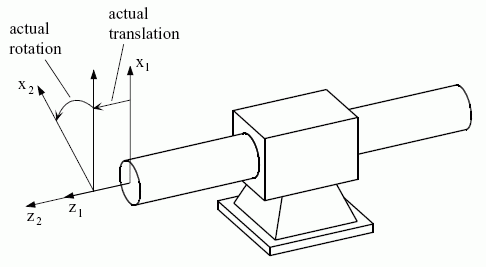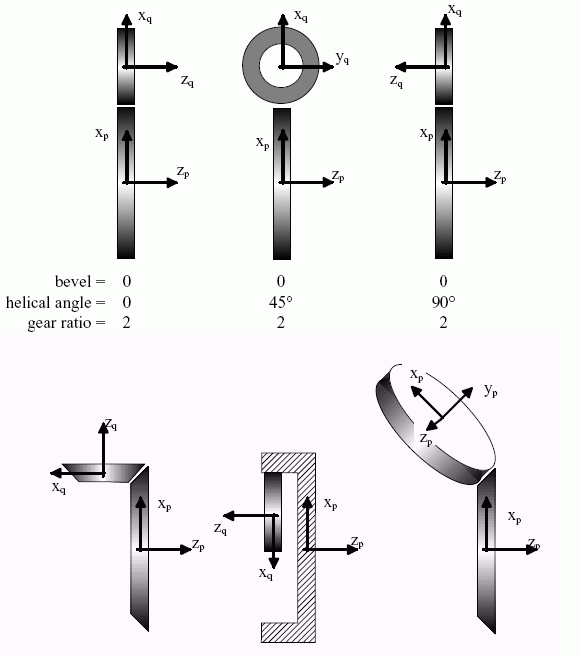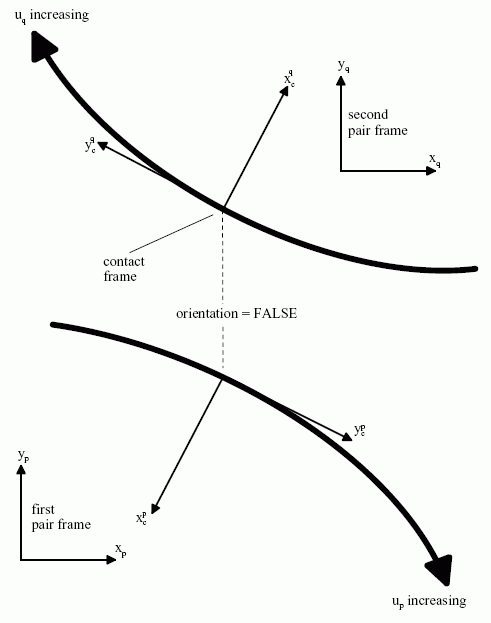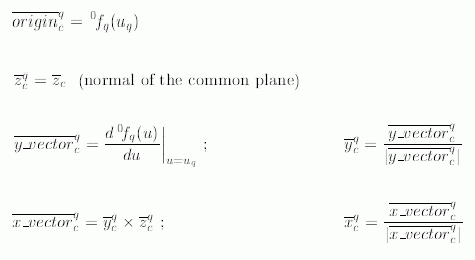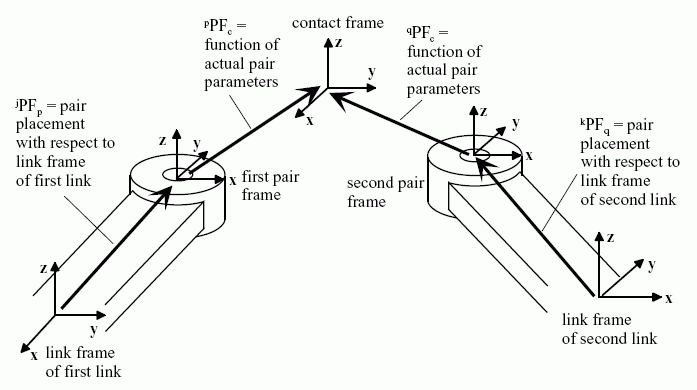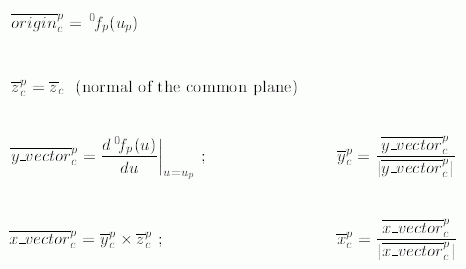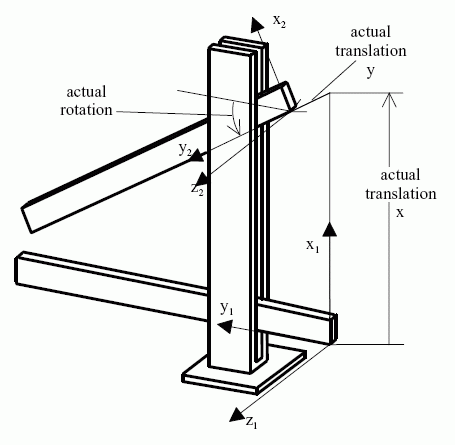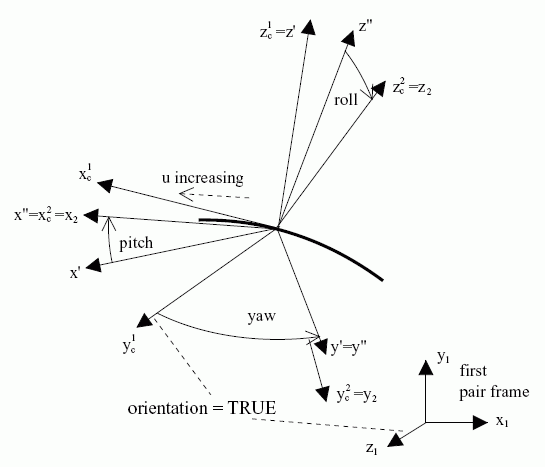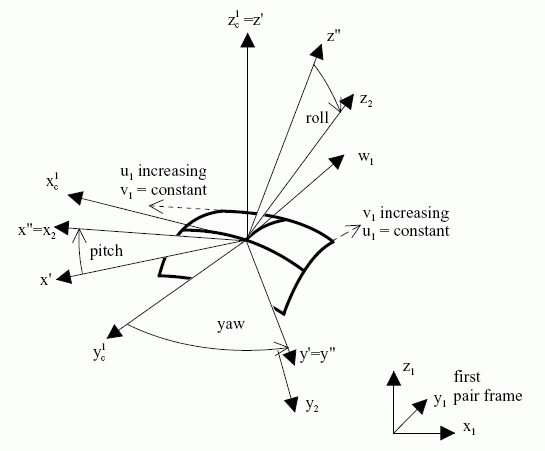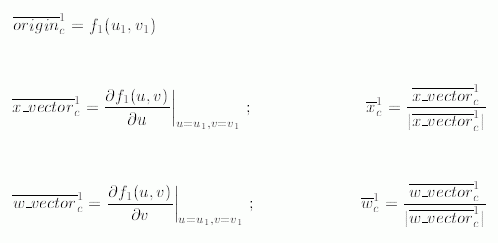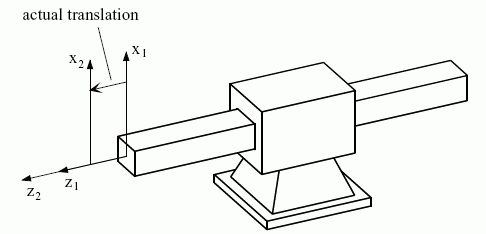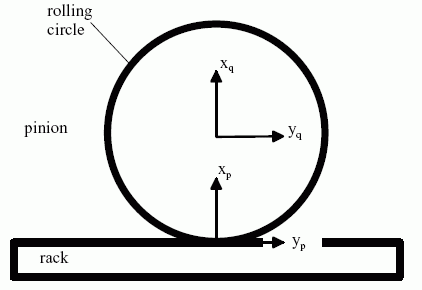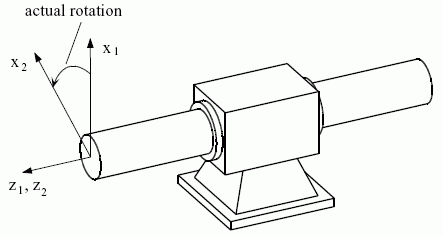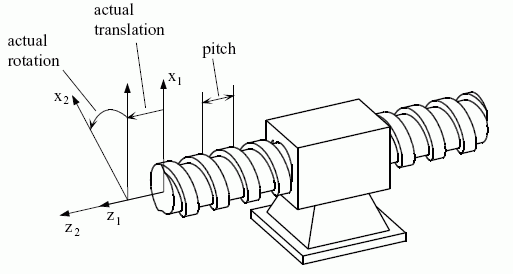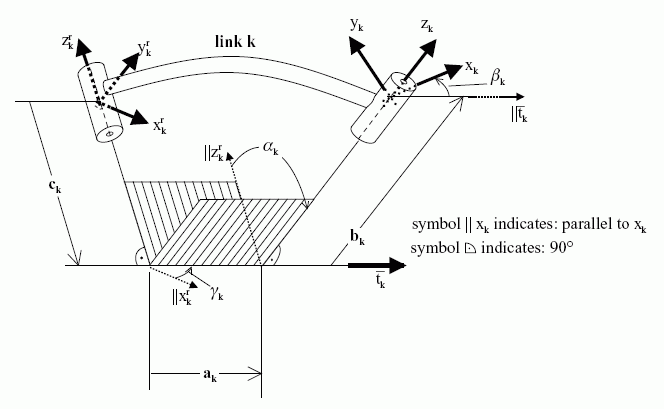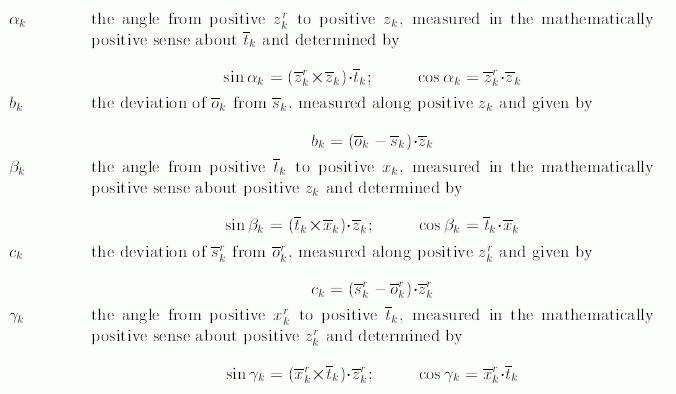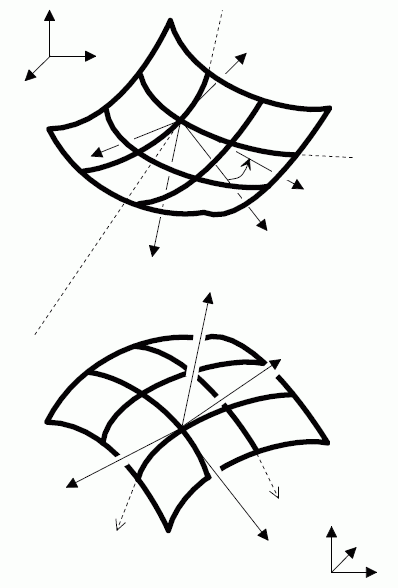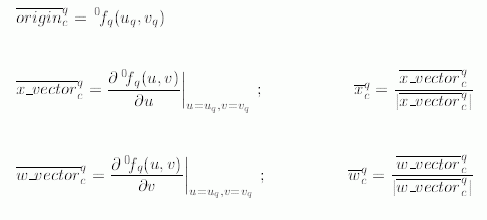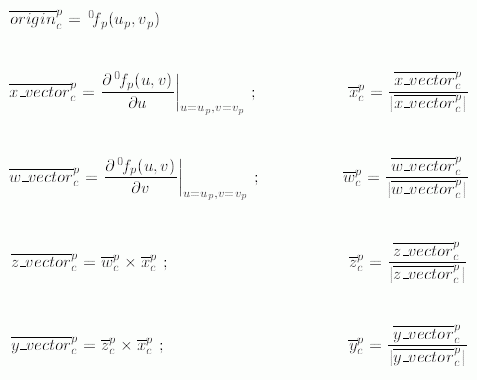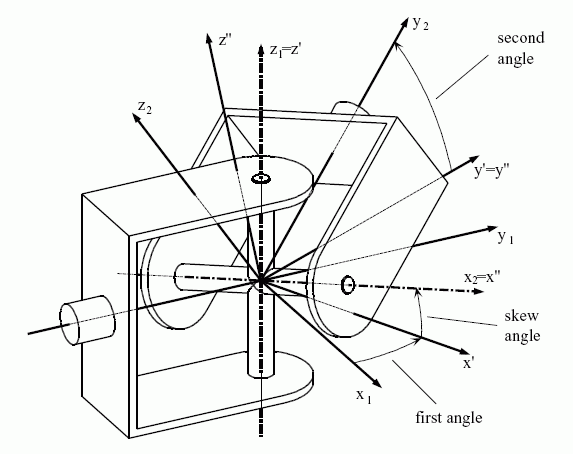|
|
Application module:
Kinematic structure |
ISO/TS 10303-1797:2018-11(E)
© ISO
|
This clause specifies the information requirements for the
Kinematic structure
application module. The information requirements are specified as the
Application Reference Model (ARM) of this application module.
NOTE 1 A graphical representation of the information
requirements is given in
Annex C.
NOTE 2 The mapping specification is specified in
5.1. It shows how
the information requirements are met by using common resources and
constructs defined or imported in the MIM schema of this application
module.
This clause defines the information requirements to which implementations shall
conform using the EXPRESS language as defined in ISO 10303-11.
The following begins the
Kinematic_structure_arm
schema and identifies the necessary external references.
EXPRESS specification:
*)
SCHEMA Kinematic_structure_arm;
(*
The following EXPRESS interface statements specify the elements
imported from the ARMs of other application modules.
EXPRESS specification:
*)
USE FROM
Kinematic_topology_arm;
--
ISO/TS 10303-1799
USE FROM
Basic_curve_arm;
--
ISO/TS 10303-1651
USE FROM
Assembly_structure_arm;
--
ISO/TS 10303-1026
USE FROM
Geometric_model_relationship_arm;
--
ISO/TS 10303-1403
USE FROM
Composite_surface_arm;
--
ISO/TS 10303-1525
USE FROM
Shape_property_assignment_arm;
--
ISO/TS 10303-1032
REFERENCE FROM
Kinematic_topology_arm
--
ISO/TS 10303-1799
(get_kinematic_joints_from_oriented_joints,
get_kinematic_joints_from_kinematic_loops);
REFERENCE FROM
Foundation_representation_arm
--
ISO/TS 10303-1006
(using_representations);
(*
NOTE 1
The schemas referenced above are specified in the following
part of ISO 10303:
| Kinematic_topology_arm |
ISO/TS 10303-1799 |
| Basic_curve_arm |
ISO/TS 10303-1651 |
| Assembly_structure_arm |
ISO/TS 10303-1026 |
| Geometric_model_relationship_arm |
ISO/TS 10303-1403 |
| Composite_surface_arm |
ISO/TS 10303-1525 |
| Shape_property_assignment_arm |
ISO/TS 10303-1032 |
| Kinematic_topology_arm |
ISO/TS 10303-1799 |
| Foundation_representation_arm |
ISO/TS 10303-1006 |
NOTE 2
See Annex C,
Figures
C.1, C.2, C.3, C.4, C.5, C.6, C.7, C.8and C.9
for a graphical representation of this schema.
This subclause specifies the ARM types
for this application module. The ARM types and
definitions are specified below.
The actuated_direction type defines the actuated direction if any for a degree of freedom of an
Actuated_kinematic_pair.
EXPRESS specification:
*)
TYPE
actuated_direction =
ENUMERATION
OF
(bidirectional,
positive_only,
negative_only,
not_actuated);
END_TYPE;
(*
Enumerated item definitions:
bidirectional:
an indication that the affected degree of freedom is actuated in both directions.
positive_only:
an indication that the affected degree of freedom is actuated in positive directions only.
negative_only:
an indication that the affected degree of freedom is actuated in negative directions only.
not_actuated:
an indication that the affected degree of freedom is not actuated.
The kinematic_link_representation_items type allows for the designation of the data
types
Curve, Cartesian_point, rigid_placement, and Surface.
EXPRESS specification:
*)
TYPE
kinematic_link_representation_items =
SELECT
(Curve,
Cartesian_point,
rigid_placement,
Surface);
END_TYPE;
(*
The ks_additional_application_domain_enumeration provides predefined identifiers for the additional application domains of
Product_view_definitions.
EXPRESS specification:
*)
TYPE
ks_additional_application_domain_enumeration =
ENUMERATION
BASED_ON
additional_application_domain_enumeration
WITH
(kinematic_mechanism);
END_TYPE;
(*
Enumerated item definitions:
kinematic_mechanism:
the application domain is kinematic mechanism.
The ks_geometric_representation_select type is an extension
of the
geometric_representation_select type.
It adds the data
type
Kinematic_link_representation
to the list of alternate data types.
NOTE The list of entity data types may be
extended in application modules that use the constructs of
this module.
EXPRESS specification:
*)
TYPE
ks_geometric_representation_select =
EXTENSIBLE
GENERIC_ENTITY
SELECT
BASED_ON
geometric_representation_select
WITH
(Kinematic_link_representation);
END_TYPE;
(*
The ks_property_assignment_select type is an extension
of the
property_assignment_select type.
It adds the data
type
Assembly_component_relationship
to the list of alternate data types.
EXPRESS specification:
*)
TYPE
ks_property_assignment_select =
SELECT
BASED_ON
property_assignment_select
WITH
(Assembly_component_relationship);
END_TYPE;
(*
The rigid_placement type allows for the designation of the data
types
Axis_placement_3d, and Su_parameters.
EXPRESS specification:
*)
TYPE
rigid_placement =
SELECT
(Axis_placement_3d,
Su_parameters);
END_TYPE;
(*
This subclause specifies the ARM entities for this
module. Each ARM application entity is an atomic element that
embodies a unique application concept and contains attributes
specifying the data elements of the entity. The ARM
entities and definitions are specified below.
An Actuated_kinematic_pair is a type of
Kinematic_pair
that is actuated in one or more degrees of freedom.
NOTE
For a backward kinematic analysis, the actuated pairs are used to achieve a prescribed path or a prescribed position.
For a forward kinematic analysis, pair values may be prescribed only for actuated pairs.
EXPRESS specification:
*)
ENTITY Actuated_kinematic_pair
SUBTYPE OF (Kinematic_pair);
t_x :
OPTIONAL
actuated_direction;
t_y :
OPTIONAL
actuated_direction;
t_z :
OPTIONAL
actuated_direction;
r_x :
OPTIONAL
actuated_direction;
r_y :
OPTIONAL
actuated_direction;
r_z :
OPTIONAL
actuated_direction;
END_ENTITY;
(*
Attribute definitions:
t_x:
the
actuated_direction
along the x-axis.
The value of this attribute need not be specified.
t_y:
the
actuated_direction
along the y-axis.
The value of this attribute need not be specified.
t_z:
the
actuated_direction
along the z-axis.
The value of this attribute need not be specified.
r_x:
the
actuated_direction
around the x-axis.
The value of this attribute need not be specified.
r_y:
the
actuated_direction
around the y-axis.
The value of this attribute need not be specified.
r_z:
the
actuated_direction
around the z-axis.
The value of this attribute need not be specified.
A Context_dependent_kinematic_link_representation is the association of a
Kinematic_link_representation_association
with a
Product_definition_relationship_kinematics.
The
Kinematic_link_representation_association
identifies the shape of a
Kinematic_link_representation
as it plays the role of the
related_view
in the
Product_occurrence_definition_relationship.
EXPRESS specification:
*)
ENTITY Context_dependent_kinematic_link_representation;
representation_relation : Kinematic_link_representation_association;
represented_product_relation : Product_definition_relationship_kinematics;
END_ENTITY;
(*
Attribute definitions:
representation_relation:
a
Kinematic_link_representation_association
that is associated with the
Product_definition_relationship_kinematics.
represented_product_relation:
a
Product_definition_relationship_kinematics.
that identifies the shape of the related
Kinematic_link_representation_association
in the context of a
Product_occurrence_definition_relationship.
A Cylindrical_pair is a type of
Low_order_kinematic_pair.
A Cylindrical_pair constrains the motion between two adjacent links to a translation along a common axis and a rotation about it.
NOTE
See
Figure 1.
Figure 1 — Example of a joint representing a Cylindrical pair
To measure the displacement and the angle of rotation, a frame is defined on each of the links such that the z-axes coincide
and the positive directions agree.
The distance of translation is defined as the distance required to translate the xy-plane of the first pair frame in the
positive
direction of the common z-axis until it coincides with the xy-plane of the second pair frame.
The angle of rotation is defined as the angle required to rotate the x-axis of the first pair frame in the positive direction
around the common z-axis until its direction coincides with the direction of the x-axis of the second pair frame.
EXPRESS specification:
*)
ENTITY Cylindrical_pair
SUBTYPE OF (Low_order_kinematic_pair);
DERIVE
SELF\Low_order_kinematic_pair.t_x : BOOLEAN := FALSE;
SELF\Low_order_kinematic_pair.t_y : BOOLEAN := FALSE;
SELF\Low_order_kinematic_pair.t_z : BOOLEAN := TRUE;
SELF\Low_order_kinematic_pair.r_x : BOOLEAN := FALSE;
SELF\Low_order_kinematic_pair.r_y : BOOLEAN := FALSE;
SELF\Low_order_kinematic_pair.r_z : BOOLEAN := TRUE;
END_ENTITY;
(*
Attribute definitions:
t_x:
translation along the x-axis is constraint.
t_y:
translation along the y-axis is constraint.
t_z:
translation along the z-axis is not constraint.
r_x:
rotation around the x-axis is constraint.
r_y:
rotation around the y-axis is constraint.
r_z:
rotation around the z-axis is not constraint.
A Cylindrical_pair_with_range is a type of
Cylindrical_pair.
A Cylindrical_pair_with_range specifies the lower bound and the upper bound of the parameter range for the
Cylindrical_pair.
EXPRESS specification:
*)
ENTITY Cylindrical_pair_with_range
SUBTYPE OF (Cylindrical_pair);
lower_limit_actual_translation :
OPTIONAL
length_measure;
upper_limit_actual_translation :
OPTIONAL
length_measure;
lower_limit_actual_rotation :
OPTIONAL
plane_angle_measure;
upper_limit_actual_rotation :
OPTIONAL
plane_angle_measure;
WHERE
WR1: (NOT EXISTS(lower_limit_actual_translation)
OR
NOT EXISTS(upper_limit_actual_translation))
XOR
(lower_limit_actual_translation < upper_limit_actual_translation);
WR2: (NOT EXISTS(lower_limit_actual_rotation)
OR
NOT EXISTS(upper_limit_actual_rotation))
XOR
(lower_limit_actual_rotation < upper_limit_actual_rotation);
END_ENTITY;
(*
Attribute definitions:
lower_limit_actual_translation:
the minimum value of translation for the
Cylindrical_pair.
The value of this attribute need not be specified.
upper_limit_actual_translation:
the maximum value of translation for the
Cylindrical_pair.
The value of this attribute need not be specified.
lower_limit_actual_rotation:
the minimum value of rotation for the
Cylindrical_pair.
The value of this attribute need not be specified.
upper_limit_actual_rotation:
the maximum value of rotation for the
Cylindrical_pair.
The value of this attribute need not be specified.
Formal propositions:
WR1:
The range of translation of the
Cylindrical_pair
shall be positive when both bounds are not given as unlimited.
WR2:
The range of rotation of the
Cylindrical_pair
shall be positive when both bounds are not given as unlimited.
A Fully_constrained_pair is a type of
Low_order_kinematic_pair.
A Fully_constrained_pair prevents any relative motion between two adjacent links.
The two pair frames are always forced to coincide.
NOTE 1
The Fully_constrained_pair may be helpful in early design stages or for kinematic analysis systems, because it allows to fix
two links each to the other without changing the topological structure.
NOTE 2
The concepts of pair value and pair range are not applicable to a Fully_constrained_pair.
EXPRESS specification:
*)
ENTITY Fully_constrained_pair
SUBTYPE OF (Low_order_kinematic_pair);
DERIVE
SELF\Low_order_kinematic_pair.t_x : BOOLEAN := FALSE;
SELF\Low_order_kinematic_pair.t_y : BOOLEAN := FALSE;
SELF\Low_order_kinematic_pair.t_z : BOOLEAN := FALSE;
SELF\Low_order_kinematic_pair.r_x : BOOLEAN := FALSE;
SELF\Low_order_kinematic_pair.r_y : BOOLEAN := FALSE;
SELF\Low_order_kinematic_pair.r_z : BOOLEAN := FALSE;
END_ENTITY;
(*
Attribute definitions:
t_x:
translation along the x-axis is constraint.
t_y:
translation along the y-axis is constraint.
t_z:
translation along the z-axis is constraint.
r_x:
rotation around the x-axis is constraint.
r_y:
rotation around the y-axis is constraint.
r_z:
rotation around the z-axis is constraint.
A Gear_pair is a type of
Low_order_kinematic_pair_with_motion_coupling.
A Gear_pair constrains the motion between two adjacent links to a rolling (and potentially sliding)
motion of the second link along the first link.
To measure the motion of the second link with respect to the first link, a frame is defined on each of the links such
that the origin lies in the center of the rolling circle of the respective link.
NOTE 1
See
Figure 2,
where different values of the constants "bevel", "helical_angle", and "gear_ratio" are shown.
The lower gear always represents the first link; the upper gear is the second link.
Figure 2 — Examples of gear pairs in different situations
The direction of the z-axis is perpendicular to the plane of the circle.
In a reference situation (with both rotation values being zero) the x-axis of the first link points from the origin towards
the point of contact with the second link, while on the second link the x-axis points away from the point of contact.
Motion is measured in terms of the rotation of the contact point about the z-axis of the first link.
The motion of the second link results from an analysis of the rolling process.
At any instance the motion of the second link may be considered as a rotation of the second gear axis about the first gear
axis
while maintaining the distance (sum of the radii), the bevel, and the helical angle plus a rotation of the second gear
about its own axis according to:
Thus absolute bevel values between 0 and π/2 represent external gears while absolute bevel values between π/2 and
π represent internal gears.
The angle between the two x-axis directions is given by the bevel according to:
with bevel ∈ ]-π,π],
where in case of cos(bevel) = 0, the sign of the bevel is defined according to:
The angle between the two y-axis directions is given by the helical angle according to:
with helical_angle ∈ ]-π,π],
where in case of cos(helical_angle) = 0, the sign of the helical angle is defined according to:
NOTE 2
In some cases the gear ratio depends on the radii of the rolling circles and also on the characteristics of the gear toothing
such as in worm gears.
For this reason the gear ratio is defined and not derived from the ratio of the two radii.
Hence, the two radii are used to determine the geometrical arrangement of the two gears relative to each other in conjunction
with bevel and helical angle, while the gear ratio determines the ratio of the second gear motion with respect to the
rotation of the contact point about the first gear axis.
EXAMPLE
One way to construct the geometrical arrangement of the second gear relative to the first one is as follows:
an auxiliary frame is introduced at the point of contact with its axes xa, ya,
and za all parallel to the respective axes of the first link frame.
Now the auxiliary frame is rotated by the angle bevel about its ya-axis followed by a rotation by the
helical angle about the (previously rotated) xa-axis.
Now the xa-ya-plane represents the plane in which the second gear lies.
EXPRESS specification:
*)
ENTITY Gear_pair
SUBTYPE OF (Low_order_kinematic_pair_with_motion_coupling);
radius_first_link : length_measure;
radius_second_link : length_measure;
bevel : plane_angle_measure;
helical_angle : plane_angle_measure;
gear_ratio : REAL;
WHERE
WR1: SIZEOF( QUERY(lr <* SELF\Kinematic_pair.associated_link_representations_1 |
NOT('KINEMATIC_STRUCTURE_ARM.RIGID_LINK_REPRESENTATION' IN TYPEOF(lr)))) = 0;
END_ENTITY;
(*
Attribute definitions:
radius_first_link:
the radius of the rolling circle of the first link.
radius_second_link:
the radius of the rolling circle of the second link.
bevel:
the angle between the two x-axes.
helical_angle:
the angle between the two y-axes.
gear_ratio:
the gear ratio of the pair.
Formal propositions:
WR1:
All
Pair_representation_relationships
refering to a Gear_pair shall reference a
Rigid_link_representation
via
rep_1.
A Gear_pair_with_range is a type of
Gear_pair.
A Gear_pair_with_range specifies the lower bound and the upper bound of the parameter range of the
Gear_pair.
EXPRESS specification:
*)
ENTITY Gear_pair_with_range
SUBTYPE OF (Gear_pair);
lower_limit_actual_rotation_1 :
OPTIONAL
plane_angle_measure;
upper_limit_actual_rotation_1 :
OPTIONAL
plane_angle_measure;
WHERE
WR1: (NOT EXISTS(lower_limit_actual_rotation_1)
OR
NOT EXISTS(upper_limit_actual_rotation_1))
XOR
(lower_limit_actual_rotation_1 < upper_limit_actual_rotation_1);
END_ENTITY;
(*
Attribute definitions:
lower_limit_actual_rotation_1:
the minimum value of the pair parameter of the first link.
The value of this attribute need not be specified.
upper_limit_actual_rotation_1:
the maximum value of the pair parameter of the first link.
The value of this attribute need not be specified.
Formal propositions:
WR1:
The range of rotation of the
Gear_pair
shall be positive when both bounds are not given as unlimited.
A High_order_kinematic_pair is a type of
Kinematic_pair
that requires references to one or more surfaces or curves in order to be defined kinematically.
Each High_order_kinematic_pair is either a
Linear_flexible_and_planar_curve_pair,
a
Point_on_surface_pair,
a
Point_on_planar_curve_pair,
a
Planar_curve_pair,
or a
Surface_pair.
EXPRESS specification:
*)
ENTITY High_order_kinematic_pair
ABSTRACT SUPERTYPE
OF (ONEOF (Linear_flexible_and_planar_curve_pair,
Point_on_surface_pair,
Point_on_planar_curve_pair,
Planar_curve_pair,
Surface_pair))
SUBTYPE OF (Kinematic_pair);
WHERE
WR1: SIZEOF( QUERY(lr <* SELF\Kinematic_pair.associated_link_representations_2 |
NOT('KINEMATIC_STRUCTURE_ARM.RIGID_LINK_REPRESENTATION' IN TYPEOF(lr)))) = 0;
END_ENTITY;
(*
Formal propositions:
WR1:
All
Pair_representation_relationships
refering to a High_order_kinematic_pair shall reference a
Rigid_link_representation
via
rep_2.
A Homokinetic_pair is a type of
Universal_pair,
where the rotation of input axis and output axis are uniform.
EXPRESS specification:
*)
ENTITY Homokinetic_pair
SUBTYPE OF (Universal_pair);
WHERE
WR1: NOT EXISTS(SELF.input_skew_angle);
END_ENTITY;
(*
Formal propositions:
WR1:
The
input_skew_angle
shall be omitted.
A Kinematic_link_representation is a type of
Representation.
A Kinematic_link_representation specifies the geometric aspects of a
Kinematic_link.
The context of the representation is established by the represented_link attribute.
Each Kinematic_link_representation is either a
Linear_flexible_link_representation
or a
Rigid_link_representation.
EXPRESS specification:
*)
ENTITY Kinematic_link_representation
ABSTRACT SUPERTYPE
OF (ONEOF (Linear_flexible_link_representation,
Rigid_link_representation))
SUBTYPE OF (Representation);
SELF\Representation.context_of_items : Geometric_coordinate_space;
SELF\Representation.items : SET[1:?] OF kinematic_link_representation_items;
represented_link : Kinematic_link;
INVERSE
associated_shape_representation : SET[0:1] OF Kinematic_link_representation_association FOR rep_1;
END_ENTITY;
(*
Attribute definitions:
context_of_items:
the
Geometric_coordinate_space
providing the context for the items.
items:
an inherited attribute that shall be of type
kinematic_link_representation_items.
There shall exist one or more
kinematic_link_representation_items
for the Kinematic_link_representation.
represented_link:
the link frame of the related
Kinematic_link.
associated_shape_representation:
specifies an inverse relationship that specifies that the existence of the Kinematic_link_representation is dependent on the existence of the
Kinematic_link_representation_association
that specifies the Kinematic_link_representation as its
rep_1.
There shall exist zero or one
Kinematic_link_representation_association
for the Kinematic_link_representation.
A Kinematic_link_representation_association is a type of
Representation_relationship
that associates a
Representation
with a
Kinematic_link_representation.
NOTE
A Kinematic_link_representation_association is used to define the shape of a link by associating a
Geometric_model
to the corresponding
Kinematic_link_representation.
EXPRESS specification:
*)
ENTITY Kinematic_link_representation_association
SUBTYPE OF (Representation_relationship);
SELF\Representation_relationship.rep_1 : Kinematic_link_representation;
SELF\Representation_relationship.rep_2 : Geometric_model;
WHERE
WR1: (SELF\Representation_relationship.rep_2.context_of_items :=:
SELF\Representation_relationship.rep_1.context_of_items) OR
('CONTEXTUAL_SHAPE_POSITIONING_ARM.GEOMETRIC_MODEL_RELATIONSHIP_WITH_TRANSFORMATION' IN TYPEOF(SELF));
END_ENTITY;
(*
Attribute definitions:
rep_1:
the
Kinematic_link_representation
with which rep_2 is associated.
rep_2:
the
Geometric_model
with which rep_1 is associated.
Formal propositions:
WR1:
The
context_of_items
of
rep_2
shall be identical to the link frame of the
Kinematic_link_representation
with which
rep_2
is associated.
A Kinematic_pair is a type of
Detailed_geometric_model_element,
that defines the kinematic constraints between two adjacent links coinciding at a joint.
Each Kinematic_pair is either a
High_order_kinematic_pair,
a
Low_order_kinematic_pair_with_motion_coupling,
a
Low_order_kinematic_pair,
and/or additionally
Actuated_kinematic_pair.
EXPRESS specification:
*)
ENTITY Kinematic_pair
ABSTRACT SUPERTYPE
OF (ONEOF (High_order_kinematic_pair,
Low_order_kinematic_pair_with_motion_coupling,
Low_order_kinematic_pair)
ANDOR Actuated_kinematic_pair)
SUBTYPE OF (Detailed_geometric_model_element);
joint : Kinematic_joint;
transform_item_1 : rigid_placement;
transform_item_2 : rigid_placement;
DERIVE
associated_link_representations_1 : SET[1:?] OF Kinematic_link_representation := sort_link_associations(link_representation_associations, TRUE);
associated_link_representations_2 : SET[1:?] OF Kinematic_link_representation := sort_link_associations(link_representation_associations, FALSE);
INVERSE
link_representation_associations : SET[1:?] OF Pair_representation_relationship FOR transformation_operator;
END_ENTITY;
(*
Attribute definitions:
joint:
the joint whose motion is constrained by the Kinematic_pair.
transform_item_1:
the placement of the pair frame on the first link in the context of the first link, i.e., its link frame.
transform_item_2:
the placement of the pair frame on the second link in the context of the second link, i.e., its link frame.
associated_link_representations_1:
identifies the first
Kinematic_link_representation
that corresponds to the
edge_start
of the referenced
Kinematic_joint
associated_link_representations_2:
identifies the second
Kinematic_link_representation
that corresponds to the
edge_end
of the referenced
Kinematic_joint.
link_representation_associations:
the inverse references of Kinematic_pair by
Pair_representation_relationship.
There shall be at least one reference.
A Kinematic_property_mechanism_representation is a type of
Kinematic_property_definition_representation
that relates a
Mechanism_representation
to a
Product_definition_kinematics
together with the identification of a
Kinematic_link_representation
as the base.
EXPRESS specification:
*)
ENTITY Kinematic_property_mechanism_representation
SUBTYPE OF (Kinematic_property_definition_representation);
SELF\Property_definition_representation.used_representation : Mechanism_representation;
base : Kinematic_link_representation;
WHERE
WR1: SIZEOF( QUERY( i <* used_representation.items |
(base :=: i\Representation_relationship.rep_1) OR
(base :=: i\Representation_relationship.rep_2))) > 0;
END_ENTITY;
(*
Attribute definitions:
used_representation:
an inherited attribute that shall be of type
Mechanism_representation.
base:
a
Kinematic_link_representation
that plays the role of a base for the Kinematic_property_mechanism_representation.
Formal propositions:
WR1:
The base shall be used by the
Mechanism_representation.
A Linear_flexible_and_pinion_pair is a type of
Low_order_kinematic_pair_with_motion_coupling
that describes a linear flexible link that moves around a
rolling pinion where the rotation axis of the pinion is perpendicular to the direction of the linear flexible link.
EXPRESS specification:
*)
ENTITY Linear_flexible_and_pinion_pair
SUBTYPE OF (Low_order_kinematic_pair_with_motion_coupling);
pinion_radius : length_measure;
WHERE
WR1: SIZEOF( QUERY(lr <* SELF\Kinematic_pair.associated_link_representations_1 |
NOT('KINEMATIC_STRUCTURE_ARM.LINEAR_FLEXIBLE_LINK_REPRESENTATION' IN TYPEOF(lr)))) = 0;
END_ENTITY;
(*
Attribute definitions:
pinion_radius:
the radius of the rolling circle of the pinion.
Formal propositions:
WR1:
All
Pair_representation_relationships
refering to a Linear_flexible_and_pinion_pair shall reference a
Linear_flexible_link_representation
via
rep_1.
A Linear_flexible_and_planar_curve_pair is a type of
High_order_kinematic_pair
that describes a linear flexible link that moves around a
rotating curve where the rotation axis of the curve is perpendicular to the direction of the linear flexible link and the
curve.
EXPRESS specification:
*)
ENTITY Linear_flexible_and_planar_curve_pair
SUBTYPE OF (High_order_kinematic_pair);
pair_curve : Curve;
orientation : BOOLEAN;
WHERE
WR1: SIZEOF( QUERY(r <* SELF\Kinematic_pair.associated_link_representations_1 | NOT(pair_curve IN r.items))) = 0;
WR2: SIZEOF( QUERY(lr <* SELF\Kinematic_pair.associated_link_representations_1 |
NOT('KINEMATIC_STRUCTURE_ARM.LINEAR_FLEXIBLE_LINK_REPRESENTATION' IN TYPEOF(lr)))) = 0;
END_ENTITY;
(*
Attribute definitions:
pair_curve:
the planar curve on the first link of the pair along which the second linear flexible link is sliding.
orientation:
a flag indicating whether the x-axis-directions agree.
Formal propositions:
WR1:
The curve referenced by pair_curve shall be a member of
associated_link_representations_1.
WR2:
All
Pair_representation_relationships
refering to a Linear_flexible_and_planar_curve_pair shall reference a
Linear_flexible_link_representation
via
rep_1.
A Linear_flexible_link_representation is a type of
Kinematic_link_representation.
EXPRESS specification:
*)
ENTITY Linear_flexible_link_representation
SUBTYPE OF (Kinematic_link_representation);
END_ENTITY;
(*
A Low_order_kinematic_pair is a type of
Kinematic_pair
whose motion is constraint by simple translation or rotational parameters.
Whenever possible one of the specific subtypes
Revolute_pair,
Cylindrical_pair,
Spherical_pair,
Spherical_pair_with_pin,
Planar_pair,
Unconstrained_pair,
Fully_constrained_pair,
Prismatic_pair or
Universal_pair
shall be used. As needed translation and rotation axes hs to be replaced to achieve this.
EXPRESS specification:
*)
ENTITY Low_order_kinematic_pair
SUPERTYPE OF (ONEOF (Revolute_pair,
Cylindrical_pair,
Spherical_pair,
Spherical_pair_with_pin,
Planar_pair,
Unconstrained_pair,
Fully_constrained_pair,
Prismatic_pair,
Universal_pair))
SUBTYPE OF (Kinematic_pair);
t_x : BOOLEAN;
t_y : BOOLEAN;
t_z : BOOLEAN;
r_x : BOOLEAN;
r_y : BOOLEAN;
r_z : BOOLEAN;
WHERE
WR1: SIZEOF( QUERY(lr <* SELF\Kinematic_pair.associated_link_representations_1 |
NOT('KINEMATIC_STRUCTURE_ARM.RIGID_LINK_REPRESENTATION' IN TYPEOF(lr)))) = 0;
WR2: SIZEOF( QUERY(lr <* SELF\Kinematic_pair.associated_link_representations_2 |
NOT('KINEMATIC_STRUCTURE_ARM.RIGID_LINK_REPRESENTATION' IN TYPEOF(lr)))) = 0;
END_ENTITY;
(*
Attribute definitions:
t_x:
translation along the x-axis; a TRUE value indicates that it is not constraint.
t_y:
translation along the y-axis; a TRUE value indicates that it is not constraint.
t_z:
translation along the z-axis; a TRUE value indicates that it is not constraint.
r_x:
rotation around the x-axis; a TRUE value indicates that it is not constraint.
r_y:
rotation around the y-axis; a TRUE value indicates that it is not constraint.
r_z:
rotation around the z-axis; a TRUE value indicates that it is not constraint.
Formal propositions:
WR1:
All
Pair_representation_relationships
refering to a Low_order_kinematic_pair shall reference a
Rigid_link_representation
via
rep_1.
WR2:
All
Pair_representation_relationships
refering to a Low_order_kinematic_pair shall reference a
Rigid_link_representation
via
rep_2.
A Low_order_kinematic_pair_with_motion_coupling is a type of
Kinematic_pair.
Each Low_order_kinematic_pair_with_motion_coupling is either a
Gear_pair,
a
Linear_flexible_and_pinion_pair,
a
Rack_and_pinion_pair,
or a
Screw_pair.
EXPRESS specification:
*)
ENTITY Low_order_kinematic_pair_with_motion_coupling
ABSTRACT SUPERTYPE
OF (ONEOF (Gear_pair,
Linear_flexible_and_pinion_pair,
Rack_and_pinion_pair,
Screw_pair))
SUBTYPE OF (Kinematic_pair);
WHERE
WR1: SIZEOF( QUERY(lr <* SELF\Kinematic_pair.associated_link_representations_2 |
NOT('KINEMATIC_STRUCTURE_ARM.RIGID_LINK_REPRESENTATION' IN TYPEOF(lr)))) = 0;
END_ENTITY;
(*
Formal propositions:
WR1:
All
Pair_representation_relationships
refering to a Low_order_kinematic_pair_with_motion_coupling shall reference a
Rigid_link_representation
via
rep_2.
A Mechanism_representation is a type of
Representation
that specifies the capabilities of relative motion of its links under the constraints
imposed by its joints.
A Mechanism_representation represents either an
Kinematic_topology_directed_structure, a
Kinematic_topology_network_structure or a
Kinematic_topology_structure.
For each
Kinematic_link
a corresponding
Kinematic_link_representation
shall be provided.
For each
Kinematic_joint
a corresponding
Kinematic_pair
shall be provided.
The association between these objects is estalished by
Pair_representation_relationships
that are the items of a Mechanism_representation.
EXPRESS specification:
*)
ENTITY Mechanism_representation
SUBTYPE OF (Representation);
SELF\Representation.context_of_items : Geometric_coordinate_space;
SELF\Representation.items : SET[1:?] OF Pair_representation_relationship;
represented_topology : kinematic_topology_representation_select;
DERIVE
represented_joints : SET[1:?] OF Kinematic_joint := collect_joints(items);
WHERE
WR1: (('KINEMATIC_TOPOLOGY_ARM.KINEMATIC_TOPOLOGY_STRUCTURE' IN TYPEOF(represented_topology))
AND (represented_joints :=: represented_topology.items)) OR
(('KINEMATIC_TOPOLOGY_ARM.KINEMATIC_TOPOLOGY_DIRECTED_STRUCTURE' IN TYPEOF(represented_topology))
AND (represented_joints :=: get_kinematic_joints_from_oriented_joints(represented_topology.items))) OR
(('KINEMATIC_TOPOLOGY_ARM.KINEMATIC_TOPOLOGY_NETWORK_STRUCTURE' IN TYPEOF(represented_topology))
AND (represented_joints :=: get_kinematic_joints_from_kinematic_loops(represented_topology.items)));
END_ENTITY;
(*
Attribute definitions:
context_of_items:
an inherited attribute that shall be of type
Geometric_coordinate_space.
items:
an inherited attribute that shall be of type
Pair_representation_relationship.
There shall exist at least one
Pair_representation_relationship
for the Mechanism_representation.
represented_topology:
the represented
kinematic_topology_representation_select.
represented_joints:
the represented
Kinematic_joints.
Formal propositions:
WR1:
The Mechanism_representation shall provide exactly one pair of
Pair_representation_relationship
and
Kinematic_pair
for each
Kinematic_joint
of the represented_topology.
A Pair_representation_relationship is a type of
Detailed_geometric_model_element
and a type of
Geometric_model_relationship.
It provides the relationship between two
Kinematic_link_representations
and a
Kinematic_pair
in such a way, that they match with the underlying
Kinematic_links
of a
Kinematic_joint.
EXPRESS specification:
*)
ENTITY Pair_representation_relationship
SUBTYPE OF (Detailed_geometric_model_element, Geometric_model_relationship);
SELF\Representation_relationship.rep_1 : Kinematic_link_representation;
SELF\Representation_relationship.rep_2 : Kinematic_link_representation;
transformation_operator : Kinematic_pair;
WHERE
WR1: transformation_operator.transform_item_1 IN rep_1.items;
WR2: transformation_operator.transform_item_2 IN rep_2.items;
WR3: rep_1\kinematic_link_representation.represented_link = transformation_operator\kinematic_pair.joint.edge_start;
WR4: rep_2\kinematic_link_representation.represented_link = transformation_operator\kinematic_pair.joint.edge_end;
END_ENTITY;
(*
Attribute definitions:
rep_1:
an inherited attribute shall be of type
Kinematic_link_representation.
rep_2:
an inherited attribute shall be of type
Rigid_link_representation.
transformation_operator:
an inherited attribute shall be of type
Kinematic_pair.
Formal propositions:
WR1:
The
rigid_placement
referenced by the chain transformation_operator and
transform_item_1
shall be an element in the
items
of rep_1.
WR2:
The
rigid_placement
referenced by the chain transformation_operator and
transform_item_2
shall be an element in the
items
of rep_2.
WR3:
The
represented_link
of rep_1 shall be the same as the one referenced by the chain transformation_operator,
joint
and
edge_start.
WR4:
The
represented_link
of rep_2 shall be the same as the one referenced by the chain transformation_operator,
joint
and
edge_end.
A Planar_curve_pair is a type of
High_order_kinematic_pair.
Each Planar_curve_pair may be either a
Sliding_curve_pair
or a
Rolling_curve_pair
and/or additionally may be
Planar_curve_pair_range.
A Planar_curve_pair constrains the motion of two links along a planar curve on each of the links.
Both curves lie in a common plane whose normal is called
The point of contact lies on the curves.
The point is called the contact point, and the contact point specifies the origin of a frame called a contact frame.
The common plane is the xy-plane of the contact frame.
To measure motion, a pair frame is defined on each of the links.
The representation ƒ(u) of the two-dimensional curves is given in the xy-plane of the corresponding pair frame.
For the subsequent specification both curve representations need to be expressed in a common coordinate system.
The world coordinate system is used for this purpose.
The following notation is used:
-
up - parameter of the curve on the first link;
-
uq - parameter of the curve on the second link;
-
0ƒp(up) - representation of the curve on the first link
relative to the world coordinate system;
-
0ƒq(uq) - representation of the curve on the second link
relative to the world coordinate system;
-
xp, yp, zp - axes of the first pair frame;
-
xq, yq, zq - axes of the second pair frame;
-
xcp, ycp, zcp - axes of the contact frame,
defined with respect to the first pair frame, but not taking into account the curve orientations;
-
xcq, ycq, zcq - axes of the contact frame,
defined with respect to the second pair frame;
-
xc, yc, zc - axes of the contact frame, defined with respect
to the first pair frame after the curve orientations have been taken into account.
NOTE 1
See
Figure 3
for an exploded view of a curve pair.
In this case orientation is FALSE, as the x-axes have opposite directions.
Figure 3 — Example of a planar curve pair
The following equations apply to
Sliding_curve_pair
and
Rolling_curve_pair.
The contact frame is determined from both sides of the pair as follows, beginning with the second link:
and the three direction vectors
may be used to establish the rigid homogeneous matrix representation of the placement of the contact frame
qPFc relative to the second pair frame.
NOTE 2
See
Figure 4
for an illustration of the relationships between the frames.
Figure 4 — Placement relationships of the pair frames relative to the mating links
The same analysis is performed for the first link.
The contact point shall be identically positioned, relative to the world coordinate system, irrespective of whether it is
approached
from the second or the first link.
The z-directions are all normal to the same plane; hence
At this stage, the direction vectors
are either
In case 1, orientation is TRUE and both x-directions are identical.
In case 2, orientation is FALSE and xcp (as well as ycp)
is rotated by π about the zc direction.
EXPRESS specification:
*)
ENTITY Planar_curve_pair
SUPERTYPE OF (ONEOF (Sliding_curve_pair,
Rolling_curve_pair)
ANDOR Planar_curve_pair_range)
SUBTYPE OF (High_order_kinematic_pair);
curve_1 : Curve;
curve_2 : Curve;
orientation : BOOLEAN;
WHERE
WR1: SIZEOF( QUERY(r <* SELF\Kinematic_pair.associated_link_representations_1 | NOT(curve_1 IN r.items))) = 0;
WR2: SIZEOF( QUERY(r <* SELF\Kinematic_pair.associated_link_representations_2 | NOT(curve_2 IN r.items))) = 0;
WR3: SIZEOF( QUERY(lr <* SELF\Kinematic_pair.associated_link_representations_1 |
NOT('KINEMATIC_STRUCTURE_ARM.RIGID_LINK_REPRESENTATION' IN TYPEOF(lr)))) = 0;
END_ENTITY;
(*
Attribute definitions:
curve_1:
the contact curve on the first link, defined in the coordinate system.
This curve shall lie within a plane.
curve_2:
the contact curve on the second link, defined in the coordinate system.
This curve shall lie within a plane.
orientation:
a flag indicating whether the x-axis-directions agree.
Formal propositions:
WR1:
The curve referenced by curve_1 shall be a member of
associated_link_representations_1.
WR2:
The curve referenced by curve_2 shall be a member of
associated_link_representations_2.
WR3:
All
Pair_representation_relationships
refering to a Planar_curve_pair shall reference a
Rigid_link_representation
via
rep_1.
A Planar_curve_pair_range is a type of
Planar_curve_pair.
A Planar_curve_pair_range specifies the lower bound and the upper bound of the parameter range of the
Planar_curve_pair.
EXPRESS specification:
*)
ENTITY Planar_curve_pair_range
SUBTYPE OF (Planar_curve_pair);
range_on_curve_1 : Trimmed_curve;
range_on_curve_2 : Trimmed_curve;
WHERE
WR1: SELF\Planar_curve_pair.curve_1 :=: range_on_curve_1.basis_curve;
WR2: SELF\Planar_curve_pair.curve_2 :=: range_on_curve_2.basis_curve;
WR3: SIZEOF( QUERY(r <* SELF\Kinematic_pair.associated_link_representations_1 | NOT(range_on_curve_1 IN r.items))) = 0;
WR4: SIZEOF( QUERY(r <* SELF\Kinematic_pair.associated_link_representations_2 | NOT(range_on_curve_2 IN r.items))) = 0;
END_ENTITY;
(*
Attribute definitions:
range_on_curve_1:
the admissible range for the positional pair parameter value on the curve on the first link of the pair.
range_on_curve_2:
the admissible range for the positional pair parameter value on the curve on the second link of the pair.
Formal propositions:
WR1:
The
basis_curve
of range_on_curve_1 shall be the same as
curve_1.
WR2:
The
basis_curve
of range_on_curve_2 shall be the same as
curve_2.
WR3:
The curve referenced by range_on_curve_1 shall be a member of
associated_link_representations_1.
WR4:
The curve referenced by range_on_curve_2 shall be a member of
associated_link_representations_2.
A Planar_pair is a type of
Low_order_kinematic_pair.
A Planar_pair constrains the motion between two adjacent links to translations along the x-axis and y-axis and a rotation
about the z-axis.
To measure the translations and the angle of rotation, a frame is defined on each of the links such that the x-, y-, and
z-axes coincide
and the positive directions agree.
The translations in x- and y-directions are defined as the displacements required to translate the origin of the first pair
frame
in positive direction of the x- and y-axes until it coincides with the origin of the second pair frame.
The angle of rotation is defined as the angle required to rotate the x-axis of the first pair frame in positive direction
around the common z-axis until its direction coincides with the direction of the x-axis of the second pair frame.
NOTE
See
Figure 5.
Figure 5 — Example of a joint representing a planar pair
EXPRESS specification:
*)
ENTITY Planar_pair
SUBTYPE OF (Low_order_kinematic_pair);
DERIVE
SELF\Low_order_kinematic_pair.t_x : BOOLEAN := TRUE;
SELF\Low_order_kinematic_pair.t_y : BOOLEAN := TRUE;
SELF\Low_order_kinematic_pair.t_z : BOOLEAN := FALSE;
SELF\Low_order_kinematic_pair.r_x : BOOLEAN := FALSE;
SELF\Low_order_kinematic_pair.r_y : BOOLEAN := FALSE;
SELF\Low_order_kinematic_pair.r_z : BOOLEAN := TRUE;
END_ENTITY;
(*
Attribute definitions:
t_x:
translation along the x-axis is not constraint.
t_y:
translation along the y-axis is not constraint.
t_z:
translation along the z-axis is constraint.
r_x:
rotation around the x-axis is constraint.
r_y:
rotation around the y-axis is constraint.
r_z:
rotation around the z-axis is not constraint.
A Planar_pair_with_range is a type of
Planar_pair.
A Planar_pair_with_range specifies the lower bound and the upper bound of the parameter range for the
Planar_pair.
EXPRESS specification:
*)
ENTITY Planar_pair_with_range
SUBTYPE OF (Planar_pair);
lower_limit_actual_rotation :
OPTIONAL
plane_angle_measure;
upper_limit_actual_rotation :
OPTIONAL
plane_angle_measure;
lower_limit_actual_translation_x :
OPTIONAL
length_measure;
upper_limit_actual_translation_x :
OPTIONAL
length_measure;
lower_limit_actual_translation_y :
OPTIONAL
length_measure;
upper_limit_actual_translation_y :
OPTIONAL
length_measure;
WHERE
WR1: (NOT EXISTS(lower_limit_actual_rotation)
OR
NOT EXISTS(upper_limit_actual_rotation))
XOR
(lower_limit_actual_rotation < upper_limit_actual_rotation);
WR2: (NOT EXISTS(lower_limit_actual_translation_x)
OR
NOT EXISTS(upper_limit_actual_translation_x))
XOR
(lower_limit_actual_translation_x < upper_limit_actual_translation_x);
WR3: (NOT EXISTS(lower_limit_actual_translation_y)
OR
NOT EXISTS(upper_limit_actual_translation_y))
XOR
(lower_limit_actual_translation_y < upper_limit_actual_translation_y);
END_ENTITY;
(*
Attribute definitions:
lower_limit_actual_rotation:
the minimum value of the angle of rotation for the
Planar_pair.
The value of this attribute need not be specified.
upper_limit_actual_rotation:
the maximum value of the angle of rotation for the
Planar_pair.
The value of this attribute need not be specified.
lower_limit_actual_translation_x:
the minimum value of translation in x-direction for the
Planar_pair.
The value of this attribute need not be specified.
upper_limit_actual_translation_x:
the maximum value of translation in x-direction for the
Planar_pair.
The value of this attribute need not be specified.
lower_limit_actual_translation_y:
the minimum value of translation in y-direction for the
Planar_pair.
The value of this attribute need not be specified.
upper_limit_actual_translation_y:
the maximum value of translation in y-direction for the
Planar_pair.
The value of this attribute need not be specified.
Formal propositions:
WR1:
The range of rotation of the
Planar_pair
shall be positive when both bounds are not given as unlimited.
WR2:
The range of translation in x-direction of the
Planar_pair
shall be positive when both bounds are not given as unlimited.
WR3:
The range of translation in y-direction of the
Planar_pair
shall be positive when both bounds are not given as unlimited.
A Point_on_planar_curve_pair is a type of
High_order_kinematic_pair
A Point_on_planar_curve_pair constrains the motion of two links such that a point defined on the second link always
lies on a planar curve defined on the first link.
The actual location of this point on the curve is called the contact point.
NOTE 1
Translational motion of the second link is constrained to the one-dimensional parameter space of the curve,
while its rotational motion about the contact point is not constrained.
Therefore, a Point_on_planar_curve_pair behaves like a
Spherical_pair
that additionally may move along a curve on the first link.
The contact point specifies the origin of a frame called the contact frame.
The x-axis of the contact frame is parallel to the tangent to the curve in the contact point and points into the
direction where the curve parameter increases.
The y-axis of the contact frame is normal to the plane in which the curve is defined.
Hence, the z-axis of the contact frame coincides with a local normal to the curve which lies in the plane of the curve
and passes the contact point.
NOTE 2
See
Figure 6.
In this case orientation is TRUE, as the yc1-axis has the same direction as the z1-axis.
Figure 6 — Example of a point on planar curve pair
To support the measure of motion, a pair frame is defined on each of the links.
The representation ƒ(u) of the two-dimensional curve is given in the xy-plane of the pair frame on the first link.
Therefore, the z-axis of this pair frame always serves as the normal to the plane of the curve.
NOTE 3
The definition of the curve plane and of its normal as specified here becomes important for cases where the curve is a straight
line.
The translational motion is given by the actual curve parameter of the contact point, u1.
The three angles of rotation are defined as the
yaw,
pitch,
and
roll
angles.
They are required to rotate the x-, y-, and z-axes of the contact frame until its directions coincide with
the axis directions of the second pair frame.
The origin of the pair frame on the second link coincides with the contact point, and the axes of this pair frame agree
with the axes of the contact frame when all three rotations have been performed.
The following notation is used in the subsequent specification:
-
u - parameter of the curve on the first link;
-
u1 - parameter of the contact point on the curve on the first link;
-
ƒ(u) - representation of the curve on the first link relative to the first pair frame;
-
x1, y1, z1 - axes of the first pair frame;
-
x2, y2, z2 - axes of the second pair frame;
-
xc1, yc1, zc1 - axes of the contact frame,
defined with respect to the first pair frame, but not taking into account the rotational motion;
-
x', y', z' - axes of the contact frame, defined with respect to the first pair frame,
when the yaw rotation has been taken into account;
-
x", y", z" - axes of the contact frame, defined with respect to the first pair frame,
when the yaw and pitch rotations have been taken into account;
-
xc2, yc2, zc2 - axes of the contact frame,
defined with respect to the first pair frame, when all the ypr rotations have been taken into account;
In order to migrate from the first pair frame to the second pair frame, the following sequence of transformations has to
be performed:
-
Establish the contact frame 1PFc relative to the first pair frame:
yc1 is required to be parallel to z1; hence, either
or
In the first case, orientation is TRUE and the direction of yc1
agrees with that of z1.
In the second case, orientation is FALSE and the direction of yc1 is opposite to that of z1.
and the three direction vectors
may be used to establish the rigid homogeneous matrix representation of the placement of the contact frame
1PFc relative to the first pair frame.
-
Rotate the xc1 ,yc1-axes about the zc1-axis
by the amount specified by the yaw angle.
This yields an intermediate frame the axes of which are denoted by
(x', y', z' = zc1 ).
-
Rotate the z',x'-axes about the y'-axis by the amount specified by the pitch angle.
This yields a second intermediate frame denoted by
(x", y" = y', z").
-
Finally, rotate the y",z"-axes about the x"-axis by the amount specified by the roll angle.
The resulting frame
(xc2 = x", yc2, zc2)
now coincides with the pair frame on the second link, denoted by (x2, y2, z2).
EXPRESS specification:
*)
ENTITY Point_on_planar_curve_pair
SUBTYPE OF (High_order_kinematic_pair);
pair_curve : Curve;
orientation : BOOLEAN;
WHERE
WR1: SIZEOF( QUERY(r <* SELF\Kinematic_pair.associated_link_representations_1 | NOT(pair_curve IN r.items))) = 0;
WR2: SIZEOF( QUERY(lr <* SELF\Kinematic_pair.associated_link_representations_1 |
NOT('KINEMATIC_STRUCTURE_ARM.RIGID_LINK_REPRESENTATION' IN TYPEOF(lr)))) = 0;
END_ENTITY;
(*
Attribute definitions:
pair_curve:
the planar curve on the first link of the pair on which the point on the second link is sliding.
orientation:
a flag indicating whether the y-axis of the unrotated contact frame agrees with the z-axis of the pair frame on the first
link.
Formal propositions:
WR1:
The curve referenced by pair_curve shall be a member of
associated_link_representations_1.
WR2:
All
Pair_representation_relationships
refering to a Point_on_planar_curve_pair shall reference a
Rigid_link_representation
via
rep_1.
A Point_on_planar_curve_pair_with_range is a type of
Point_on_planar_curve_pair
A Point_on_planar_curve_pair_with_range specifies the lower bound and the upper bound of the parameter range for the
Point_on_planar_curve_pair.
EXPRESS specification:
*)
ENTITY Point_on_planar_curve_pair_with_range
SUBTYPE OF (Point_on_planar_curve_pair);
range_on_pair_curve : Trimmed_curve;
lower_limit_yaw :
OPTIONAL
plane_angle_measure;
upper_limit_yaw :
OPTIONAL
plane_angle_measure;
lower_limit_pitch :
OPTIONAL
plane_angle_measure;
upper_limit_pitch :
OPTIONAL
plane_angle_measure;
lower_limit_roll :
OPTIONAL
plane_angle_measure;
upper_limit_roll :
OPTIONAL
plane_angle_measure;
WHERE
WR1: (NOT EXISTS(lower_limit_pitch)
OR
NOT EXISTS(upper_limit_pitch))
XOR
(lower_limit_pitch < upper_limit_pitch);
WR2: (NOT EXISTS(lower_limit_yaw)
OR
NOT EXISTS(upper_limit_yaw))
XOR
(lower_limit_yaw < upper_limit_yaw);
WR3: (NOT EXISTS(lower_limit_roll)
OR
NOT EXISTS(upper_limit_roll))
XOR
(lower_limit_roll < upper_limit_roll);
WR4: SIZEOF( QUERY(r <* SELF\Kinematic_pair.associated_link_representations_1 | NOT(range_on_pair_curve IN r.items))) = 0;
END_ENTITY;
(*
Attribute definitions:
range_on_pair_curve:
the admissible range for the positional pair parameter value on the contact curve on the first link.
lower_limit_yaw:
the minimum value of the yaw angle for the
Point_on_planar_curve_pair.
The value of this attribute need not be specified.
upper_limit_yaw:
the maximum value of the yaw angle for the
Point_on_planar_curve_pair.
The value of this attribute need not be specified.
lower_limit_pitch:
the minimum value of the pitch angle for the
Point_on_planar_curve_pair.
The value of this attribute need not be specified.
upper_limit_pitch:
the maximum value of the pitch angle for the
Point_on_planar_curve_pair.
The value of this attribute need not be specified.
lower_limit_roll:
the minimum value of the roll angle for the
Point_on_planar_curve_pair.
The value of this attribute need not be specified.
upper_limit_roll:
the maximum value of the roll angle for the
Point_on_planar_curve_pair.
The value of this attribute need not be specified.
Formal propositions:
WR1:
The range of rotation about the x-axis of the
Point_on_planar_curve_pair
shall be positive when both bounds are not given as unlimited.
WR2:
The range of rotation about the y-axis of the
Point_on_planar_curve_pair
shall be positive when both bounds are not given as unlimited.
WR3:
The range of rotation about the z-axis of the
Point_on_planar_curve_pair
shall be positive when both bounds are not given as unlimited.
WR4:
The curve referenced by range_on_pair_curve shall be a member of
associated_link_representations_1.
A Point_on_surface_pair is a type of
High_order_kinematic_pair.
A Point_on_surface_pair constrains the motion of two links such that a point defined on the second link always lies on
a surface defined on the first link.
The actual location of this point on the surface is called the contact point.
The contact point specifies an origin of a frame called the contact frame.
The local normal to the surface in the contact point coincides with the z-axis of the contact frame.
The x-axis of the contact frame is parallel to the tangent to the iso-parameter line of the surface for the first surface
parameter,
which passes the contact point, and points into the direction where the first surface parameter increases.
NOTE 1
Translational motion of the second link is constrained to the two-dimensional parameter space of the surface,
while its rotational motion about the contact point is not constrained.
Therefore, a Point_on_surface_pair behaves like a
Spherical_pair
that additionally may move along a surface on the first link.
NOTE 2
See
Figure 7.
Figure 7 — Example of a point on surface pair
To support the measure of motion, a pair frame is defined on each of the links.
The representation ƒ1(u, v) is defined relative to the pair frame on the first link.
The translational motion is given by the actual surface parameters of the contact point, u1 and v1.
The three angles of rotation are defined as the
yaw,
pitch, and
roll angles.
They are required to rotate the x-, y-, and z-axes of the contact frame until its directions coincide with the axis directions
of the second pair frame. The origin of the pair frame on the second link coincides with the contact point.
In order to migrate from the first pair frame to the second pair frame, the following sequence of transformations has to
be performed:
-
Establish the contact frame 1PFc relative to the first pair frame:
and the three direction vectors
may be used to establish the rigid homogeneous matrix representation of the placement of the contact frame
1PFc relative to the first pair frame.
-
Rotate the xc1,yc1 -axes about the zc1 -axis
by the amount specified by the yaw angle.
This yields an intermediate frame the axes of which are denoted by (x', y', z' = zc1).
-
Rotate the z',x'-axes about the y'-axis by the amount specified by the pitch angle.
This yields a second intermediate frame denoted by (x", y" = y'; z").
-
Finally, rotate the y",z"-axes about the x"-axis by the amount specified by the roll angle.
The resulting frame (x2 = x", y2, z2) now coincides
with the pair frame on the second link.
EXPRESS specification:
*)
ENTITY Point_on_surface_pair
SUBTYPE OF (High_order_kinematic_pair);
pair_surface : Surface;
WHERE
WR1: SIZEOF( QUERY(r <* SELF\Kinematic_pair.associated_link_representations_1 | NOT(pair_surface IN r.items))) = 0;
WR2: SIZEOF( QUERY(lr <* SELF\Kinematic_pair.associated_link_representations_1 |
NOT('KINEMATIC_STRUCTURE_ARM.RIGID_LINK_REPRESENTATION' IN TYPEOF(lr)))) = 0;
END_ENTITY;
(*
Attribute definitions:
pair_surface:
the surface on the first link of the pair on which the point on the second link is sliding.
Formal propositions:
WR1:
The surface referenced by pair_surface shall be a member of
associated_link_representations_1.
WR2:
All
Pair_representation_relationships
refering to a Point_on_surface_pair shall reference a
Rigid_link_representation
via
rep_1.
A Point_on_surface_pair_with_range is a type of
Point_on_surface_pair.
A Point_on_surface_pair_with_range specifies the lower bound and the upper bound of the parameter range for the
Point_on_surface_pair.
EXPRESS specification:
*)
ENTITY Point_on_surface_pair_with_range
SUBTYPE OF (Point_on_surface_pair);
range_on_pair_surface : Trimmed_surface;
lower_limit_yaw :
OPTIONAL
plane_angle_measure;
upper_limit_yaw :
OPTIONAL
plane_angle_measure;
lower_limit_pitch :
OPTIONAL
plane_angle_measure;
upper_limit_pitch :
OPTIONAL
plane_angle_measure;
lower_limit_roll :
OPTIONAL
plane_angle_measure;
upper_limit_roll :
OPTIONAL
plane_angle_measure;
WHERE
WR1: (NOT EXISTS(lower_limit_pitch)
OR
NOT EXISTS(upper_limit_pitch))
XOR
(lower_limit_pitch < upper_limit_pitch);
WR2: (NOT EXISTS(lower_limit_yaw)
OR
NOT EXISTS(upper_limit_yaw))
XOR
(lower_limit_yaw < upper_limit_yaw);
WR3: (NOT EXISTS(lower_limit_roll)
OR
NOT EXISTS(upper_limit_roll))
XOR
(lower_limit_roll < upper_limit_roll);
WR4: SIZEOF( QUERY(r <* SELF\Kinematic_pair.associated_link_representations_1 | NOT(range_on_pair_surface IN r.items))) =
0;
END_ENTITY;
(*
Attribute definitions:
range_on_pair_surface:
the admissible range for the positional pair parameter value on the contact surface on the first link.
lower_limit_yaw:
the minimum value of the yaw angle for the
Point_on_surface_pair.
The value of this attribute need not be specified.
upper_limit_yaw:
the maximum value of the yaw angle for the
Point_on_surface_pair.
The value of this attribute need not be specified.
lower_limit_pitch:
the minimum value of the pitch angle for the
Point_on_surface_pair.
The value of this attribute need not be specified.
upper_limit_pitch:
the maximum value of the pitch angle for the
Point_on_surface_pair.
The value of this attribute need not be specified.
lower_limit_roll:
the minimum value of the roll angle for the
Point_on_surface_pair.
The value of this attribute need not be specified.
upper_limit_roll:
the maximum value of the roll angle for the
Point_on_surface_pair.
The value of this attribute need not be specified.
Formal propositions:
WR1:
The range of rotation about the x-axis of the
Point_on_surface_pair
shall be positive when both bounds are not given as unlimited.
WR2:
The range of rotation about the y-axis of the
Point_on_surface_pair
shall be positive when both bounds are not given as unlimited.
WR3:
The range of rotation about the z-axis of the
Point_on_surface_pair
shall be positive when both bounds are not given as unlimited.
WR4:
The surface referenced by range_on_pair_surface shall be a member of
associated_link_representations_1.
A Prismatic_pair is a type of
Low_order_kinematic_pair.
A Prismatic_pair constrains the motion between two adjacent links to a translation along a common axis.
To measure the distance of translation a frame is defined on each of the links such that their corresponding coordinate axes
coincide
and their positive directions agree.
The motion of the second link with respect to the first link is defined as the distance required to
translate the xy-plane of the first pair frame in positive direction of the common z-axis until it
coincides with the xy-plane of the second pair frame.
NOTE
See
Figure 8.
Figure 8 — Example of a joint representing a prismatic pair
EXPRESS specification:
*)
ENTITY Prismatic_pair
SUBTYPE OF (Low_order_kinematic_pair);
DERIVE
SELF\Low_order_kinematic_pair.t_x : BOOLEAN := TRUE;
SELF\Low_order_kinematic_pair.t_y : BOOLEAN := FALSE;
SELF\Low_order_kinematic_pair.t_z : BOOLEAN := FALSE;
SELF\Low_order_kinematic_pair.r_x : BOOLEAN := FALSE;
SELF\Low_order_kinematic_pair.r_y : BOOLEAN := FALSE;
SELF\Low_order_kinematic_pair.r_z : BOOLEAN := FALSE;
END_ENTITY;
(*
Attribute definitions:
t_x:
translation along the x-axis is not constraint.
t_y:
translation along the y-axis is constraint.
t_z:
translation along the z-axis is constraint.
r_x:
rotation around the x-axis is constraint.
r_y:
rotation around the y-axis is constraint.
r_z:
rotation around the z-axis is constraint.
A Prismatic_pair_with_range is a type of
Prismatic_pair.
A Prismatic_pair_with_range specifies the lower bound and the upper bound of the parameter range for the
Prismatic_pair.
EXPRESS specification:
*)
ENTITY Prismatic_pair_with_range
SUBTYPE OF (Prismatic_pair);
lower_limit_actual_translation :
OPTIONAL
length_measure;
upper_limit_actual_translation :
OPTIONAL
length_measure;
WHERE
WR1: (NOT EXISTS(lower_limit_actual_translation)
OR
NOT EXISTS(upper_limit_actual_translation))
XOR
(lower_limit_actual_translation < upper_limit_actual_translation);
END_ENTITY;
(*
Attribute definitions:
lower_limit_actual_translation:
the minimum value of the pair parameter.
The value of this attribute need not be specified.
upper_limit_actual_translation:
the maximum value of the pair parameter.
The value of this attribute need not be specified.
Formal propositions:
WR1:
The range of the
Prismatic_pair
shall be positive when both bounds are not given as unlimited.
A Product_definition_relationship_kinematics is a type of
Assigned_property.
The Product_definition_relationship_kinematics specifies the kinematic property of a product relationship.
EXPRESS specification:
*)
ENTITY Product_definition_relationship_kinematics
SUBTYPE OF (Assigned_property);
SELF\Assigned_property.described_element : Assembly_component_relationship;
UNIQUE
UR1: described_element;
END_ENTITY;
(*
Attribute definitions:
described_element:
an inherited attribute that shall be of type
Assembly_component_relationship.
Formal propositions:
UR1:
The described_element shall be unique within a population of Product_definition_relationship_kinematics.
A Rack_and_pinion_pair is a type of
Low_order_kinematic_pair_with_motion_coupling.
A Rack_and_pinion_pair describes a pinion rolling on a rack where the rotation axis of the pinion is perpendicular
to the direction of the rack.
NOTE
See
Figure 9.
The rack and pinion pair may be considered as a special case of the
Rolling_curve_pair
with one curve being a straight line and the other a circle.
Figure 9 — Example of a rack and pinion pair in the reference situation
The rack is always the first link; the pinion is the second link.
The Rack_and_pinion_pair constrains the motion between two adjacent links to a translation along a common axis and a
rotation about an axis perpendicular to it.
To measure the motion of the second link with respect to the first link, a frame is defined on each of the links.
On the pinion, the origin is the center of the rolling circle.
The direction of the z-axis on both rack and pinion is perpendicular to the plane of the circle.
In a reference situation (with both pair parameter values being zero), the x-axis of the pinion points from the origin away
from the point of contact with the rack.
In the same reference situation, the x-axis of the rack points from the point of contact towards the center of the pinion.
Motion is measured in terms of the translation of the contact point along the y-axis of the rack (first link).
The motion of the second link results from an analysis of the rolling process.
At any instance the motion of the second link is composed of a translation and a rotation where the rotation part is calculated
from:
EXPRESS specification:
*)
ENTITY Rack_and_pinion_pair
SUBTYPE OF (Low_order_kinematic_pair_with_motion_coupling);
pinion_radius : length_measure;
WHERE
WR1: SIZEOF( QUERY(lr <* SELF\Kinematic_pair.associated_link_representations_1 |
NOT('KINEMATIC_STRUCTURE_ARM.RIGID_LINK_REPRESENTATION' IN TYPEOF(lr)))) = 0;
END_ENTITY;
(*
Attribute definitions:
pinion_radius:
the radius of the rolling circle of the pinion.
Formal propositions:
WR1:
All
Pair_representation_relationships
refering to a Rack_and_pinion_pair shall reference a
Rigid_link_representation
via
rep_1.
A Rack_and_pinion_pair_with_range is a type of
Rack_and_pinion_pair.
A Rack_and_pinion_pair_with_range specifies the lower bound and the upper bound of the parameter range for the
Rack_and_pinion_pair.
EXPRESS specification:
*)
ENTITY Rack_and_pinion_pair_with_range
SUBTYPE OF (Rack_and_pinion_pair);
lower_limit_rack_displacement :
OPTIONAL
length_measure;
upper_limit_rack_displacement :
OPTIONAL
length_measure;
WHERE
WR1: (NOT EXISTS(lower_limit_rack_displacement)
OR
NOT EXISTS(upper_limit_rack_displacement))
XOR
(lower_limit_rack_displacement < upper_limit_rack_displacement);
END_ENTITY;
(*
Attribute definitions:
lower_limit_rack_displacement:
the minimum value of the pair parameter for the rack.
The value of this attribute need not be specified.
upper_limit_rack_displacement:
the maximum value of the pair parameter for the rack.
The value of this attribute need not be specified.
Formal propositions:
WR1:
The range of motion of the
Rack_and_pinion_pair
shall be positive when both bounds are not given as unlimited.
A Revolute_pair is a type of
Low_order_kinematic_pair.
A Revolute_pair constrains the motion between two adjacent links to a rotation about a common axis.
To measure the angle of rotation a frame is defined on each of the links such that local origins and the z-axes coincide
and
their positive directions agree.
The motion of the second link with respect to the first link is defined as the angle required to rotate the x-axis of
the first pair frame in positive direction around the common z-axis until it matches the x-axis of the second pair frame.
NOTE
See
Figure 10.
Figure 10 — Example of a joint representing a revolute pair
EXPRESS specification:
*)
ENTITY Revolute_pair
SUBTYPE OF (Low_order_kinematic_pair);
DERIVE
SELF\Low_order_kinematic_pair.t_x : BOOLEAN := FALSE;
SELF\Low_order_kinematic_pair.t_y : BOOLEAN := FALSE;
SELF\Low_order_kinematic_pair.t_z : BOOLEAN := FALSE;
SELF\Low_order_kinematic_pair.r_x : BOOLEAN := FALSE;
SELF\Low_order_kinematic_pair.r_y : BOOLEAN := FALSE;
SELF\Low_order_kinematic_pair.r_z : BOOLEAN := TRUE;
END_ENTITY;
(*
Attribute definitions:
t_x:
translation along the x-axis is constraint.
t_y:
translation along the y-axis is constraint.
t_z:
translation along the z-axis is constraint.
r_x:
rotation around the x-axis is constraint.
r_y:
rotation around the y-axis is constraint.
r_z:
rotation around the z-axis is not constraint.
A Revolute_pair_with_range is a type of
Revolute_pair.
A Revolute_pair_with_range specifies the lower bound and the upper bound of the parameter pair range for the
Revolute_pair.
EXPRESS specification:
*)
ENTITY Revolute_pair_with_range
SUBTYPE OF (Revolute_pair);
lower_limit_actual_rotation :
OPTIONAL
plane_angle_measure;
upper_limit_actual_rotation :
OPTIONAL
plane_angle_measure;
WHERE
WR1: (NOT EXISTS(lower_limit_actual_rotation)
OR
NOT EXISTS(upper_limit_actual_rotation))
XOR
(lower_limit_actual_rotation < upper_limit_actual_rotation);
END_ENTITY;
(*
Attribute definitions:
lower_limit_actual_rotation:
the minimum value of the pair parameter.
The value of this attribute need not be specified.
upper_limit_actual_rotation:
the maximum value of the pair parameter.
The value of this attribute need not be specified.
Formal propositions:
WR1:
The range of the
Revolute_pair
shall be positive when both bounds are not given as unlimited.
A Rigid_link_representation is a type of
Kinematic_link_representation.
EXPRESS specification:
*)
ENTITY Rigid_link_representation
SUBTYPE OF (Kinematic_link_representation);
END_ENTITY;
(*
A Rolling_curve_pair is a type of
Planar_curve_pair.
A Rolling_curve_pair specifies the rolling motion between the curves on the two links of a
Planar_curve_pair.
EXPRESS specification:
*)
ENTITY Rolling_curve_pair
SUBTYPE OF (Planar_curve_pair);
END_ENTITY;
(*
A Rolling_surface_pair is a type of
Surface_pair.
A Rolling_surface_pair specifies the rolling motion between the two contact surfaces of a
Surface_pair.
EXPRESS specification:
*)
ENTITY Rolling_surface_pair
SUBTYPE OF (Surface_pair);
END_ENTITY;
(*
A Screw_pair is a type of
Low_order_kinematic_pair_with_motion_coupling.
A Screw_pair constrains the motion between two adjacent links to a rotation about, and translation along,
a common axis, where the translation is proportional to the rotation.
The factor of proportionality is given by pitch which defines the translational displacement for one full rotation.
The frames are defined on each of the links such that the z-axes coincide and the positive directions agree.
NOTE 1
See
Figure 11.
Figure 11 — Example of a joint representing a screw pair
NOTE 2
The relationship between actual rotation and actual translation as drawn in the
figure 10
does not actually correspond to pitch.
Actual translation as drawn would result from an actual rotation covering more than a full revolution.
The motion of the second link with respect to the first link is specified by the angle required to
rotate the x-axis of the first pair frame in positive direction around the common z-axis until its
direction coincides with the direction of the x-axis of the second pair frame.
The translation of the second link along the z-axis shall depend on the rotation according to
where actual rotation is given in radians.
Hence a full rotation (actual rotation = 2π) displaces the xy-plane of the second pair frame by
the value pitch in the positive z-direction relative to the first pair frame.
NOTE 3
The Screw_pair does not distinguish which one of its links is driving or driven.
EXPRESS specification:
*)
ENTITY Screw_pair
SUBTYPE OF (Low_order_kinematic_pair_with_motion_coupling);
pitch : length_measure;
WHERE
WR1: SIZEOF( QUERY(lr <* SELF\Kinematic_pair.associated_link_representations_1 |
NOT('KINEMATIC_STRUCTURE_ARM.RIGID_LINK_REPRESENTATION' IN TYPEOF(lr)))) = 0;
END_ENTITY;
(*
Attribute definitions:
pitch:
the pitch of the screw.
Formal propositions:
WR1:
All
Pair_representation_relationships
refering to a Screw_pair shall reference a
Rigid_link_representation
via
rep_1.
A Screw_pair_with_range is a type of
Screw_pair.
A Screw_pair_with_ranges specifies the lower bound and the upper bound of the parameter range for the
Screw_pair.
EXPRESS specification:
*)
ENTITY Screw_pair_with_range
SUBTYPE OF (Screw_pair);
lower_limit_actual_rotation :
OPTIONAL
plane_angle_measure;
upper_limit_actual_rotation :
OPTIONAL
plane_angle_measure;
WHERE
WR1: (NOT EXISTS(lower_limit_actual_rotation)
OR
NOT EXISTS(upper_limit_actual_rotation))
XOR
(lower_limit_actual_rotation < upper_limit_actual_rotation);
END_ENTITY;
(*
Attribute definitions:
lower_limit_actual_rotation:
the minimum value of the pair parameter.
The value of this attribute need not be specified.
upper_limit_actual_rotation:
the maximum value of the pair parameter.
The value of this attribute need not be specified.
Formal propositions:
WR1:
The range of the
Screw_pair
shall be positive when both bounds are not given as unlimited.
A Sliding_curve_pair is a type of
Planar_curve_pair.
A Sliding_curve_pair specifies the sliding motion between the curves on the two links of a
Planar_curve_pair.
EXPRESS specification:
*)
ENTITY Sliding_curve_pair
SUBTYPE OF (Planar_curve_pair);
END_ENTITY;
(*
A Sliding_surface_pair is a type of
Surface_pair.
A Sliding_surface_pair specifies the sliding motion between the two contact surfaces of a
Surface_pair.
EXPRESS specification:
*)
ENTITY Sliding_surface_pair
SUBTYPE OF (Surface_pair);
END_ENTITY;
(*
A Spherical_pair is a type of
Low_order_kinematic_pair.
A Spherical_pair constrains the motion between two adjacent links to the rotation about three independent axes that
intersect in a common point.
To measure the three angles of rotation, a frame system is defined on each of the links such that the origins of the frames
coincide.
The three angles of rotation are defined as the yaw, pitch, and roll angles.
They are required to rotate the x-, y-, and z-axes of the first pair frame until the axis directions of this frame coincide
with the axis directions of the second pair frame.
NOTE 1
See
Figure 12.
Figure 12 — Example of a joint representing a spherical pair
NOTE 2
(x1, y1, z1) is the frst pair frame,
and (x2, y2, z2) is the second pair frame.
(x', y', z') is an intermediate frame resulting from the yaw rotation of
(x1, y1, z1) about z1.
(x", y", z") results from the pitch rotation of
(x', y', z') about y'.
The roll rotation of (x", y", z") about x" produces
(x2, y2, z2).
EXPRESS specification:
*)
ENTITY Spherical_pair
SUBTYPE OF (Low_order_kinematic_pair);
DERIVE
SELF\Low_order_kinematic_pair.t_x : BOOLEAN := FALSE;
SELF\Low_order_kinematic_pair.t_y : BOOLEAN := FALSE;
SELF\Low_order_kinematic_pair.t_z : BOOLEAN := FALSE;
SELF\Low_order_kinematic_pair.r_x : BOOLEAN := TRUE;
SELF\Low_order_kinematic_pair.r_y : BOOLEAN := TRUE;
SELF\Low_order_kinematic_pair.r_z : BOOLEAN := TRUE;
END_ENTITY;
(*
Attribute definitions:
t_x:
translation along the x-axis is constraint.
t_y:
translation along the y-axis is constraint.
t_z:
translation along the z-axis is constraint.
r_x:
rotation around the x-axis is not constraint.
r_y:
rotation around the y-axis is not constraint.
r_z:
rotation around the z-axis is not constraint.
A Spherical_pair_with_pin is a type of
Low_order_kinematic_pair.
A Spherical_pair_with_pin constrains the motion between two adjacent links to the rotation about two independent axes that
intersect in a common point.
To measure the two angles of rotation, a frame system is defined on each of the links such that the origins of the frames
coincide.
The two angles of rotation are defined as the yaw and pitch angles.
They are required to rotate the y-, and z-axes of the first pair frame until the axis directions of this frame coincide
with the axis directions of the second pair frame.
EXPRESS specification:
*)
ENTITY Spherical_pair_with_pin
SUBTYPE OF (Low_order_kinematic_pair);
DERIVE
SELF\Low_order_kinematic_pair.t_x : BOOLEAN := FALSE;
SELF\Low_order_kinematic_pair.t_y : BOOLEAN := FALSE;
SELF\Low_order_kinematic_pair.t_z : BOOLEAN := FALSE;
SELF\Low_order_kinematic_pair.r_x : BOOLEAN := FALSE;
SELF\Low_order_kinematic_pair.r_y : BOOLEAN := TRUE;
SELF\Low_order_kinematic_pair.r_z : BOOLEAN := TRUE;
END_ENTITY;
(*
Attribute definitions:
t_x:
translation along the x-axis is constraint.
t_y:
translation along the y-axis is constraint.
t_z:
translation along the z-axis is constraint.
r_x:
rotation around the x-axis is constraint.
r_y:
rotation around the y-axis is not constraint.
r_z:
rotation around the z-axis is not constraint.
A Spherical_pair_with_pin_and_range is a type of
Spherical_pair_with_pin.
A Spherical_pair_with_pin_and_range specifies the lower bound and the upper bound of the parameter range for a
Spherical_pair.
EXPRESS specification:
*)
ENTITY Spherical_pair_with_pin_and_range
SUBTYPE OF (Spherical_pair_with_pin);
lower_limit_yaw :
OPTIONAL
plane_angle_measure;
upper_limit_yaw :
OPTIONAL
plane_angle_measure;
lower_limit_roll :
OPTIONAL
plane_angle_measure;
upper_limit_roll :
OPTIONAL
plane_angle_measure;
WHERE
WR1: (NOT EXISTS(lower_limit_yaw)
OR
NOT EXISTS(upper_limit_yaw))
XOR
(lower_limit_yaw < upper_limit_yaw);
WR2: (NOT EXISTS(lower_limit_roll)
OR
NOT EXISTS(upper_limit_roll))
XOR
(lower_limit_roll < upper_limit_roll);
END_ENTITY;
(*
Attribute definitions:
lower_limit_yaw:
the minimum value of the yaw angle for the
Spherical_pair.
The value of this attribute need not be specified.
upper_limit_yaw:
the maximum value of the yaw angle for the
Spherical_pair.
The value of this attribute need not be specified.
lower_limit_roll:
the minimum value of the roll angle for the
Spherical_pair.
The value of this attribute need not be specified.
upper_limit_roll:
the maximum value of the roll angle for the
Spherical_pair.
The value of this attribute need not be specified.
Formal propositions:
WR1:
The range of rotation about the z-axis of the
Spherical_pair
shall be positive when both bounds are not given as unlimited.
WR2:
The range of rotation about the y-axis of the
Spherical_pair
shall be positive when both bounds are not given as unlimited.
A Spherical_pair_with_range is a type of
Spherical_pair.
A Spherical_pair_with_range specifies the lower bound and the upper bound of the parameter range for a
Spherical_pair.
EXPRESS specification:
*)
ENTITY Spherical_pair_with_range
SUBTYPE OF (Spherical_pair);
lower_limit_yaw :
OPTIONAL
plane_angle_measure;
upper_limit_yaw :
OPTIONAL
plane_angle_measure;
lower_limit_pitch :
OPTIONAL
plane_angle_measure;
upper_limit_pitch :
OPTIONAL
plane_angle_measure;
lower_limit_roll :
OPTIONAL
plane_angle_measure;
upper_limit_roll :
OPTIONAL
plane_angle_measure;
WHERE
WR1: (NOT EXISTS(lower_limit_yaw)
OR
NOT EXISTS(upper_limit_yaw))
XOR
(lower_limit_yaw < upper_limit_yaw);
WR2: (NOT EXISTS(lower_limit_pitch)
OR
NOT EXISTS(upper_limit_pitch))
XOR
(lower_limit_pitch < upper_limit_pitch);
WR3: (NOT EXISTS(lower_limit_roll)
OR
NOT EXISTS(upper_limit_roll))
XOR
(lower_limit_roll < upper_limit_roll);
END_ENTITY;
(*
Attribute definitions:
lower_limit_yaw:
the minimum value of the yaw angle for the
Spherical_pair.
The value of this attribute need not be specified.
upper_limit_yaw:
the maximum value of the yaw angle for the
Spherical_pair.
The value of this attribute need not be specified.
lower_limit_pitch:
the minimum value of the pitch angle for the
Spherical_pair.
The value of this attribute need not be specified.
upper_limit_pitch:
the maximum value of the pitch angle for the
Spherical_pair.
The value of this attribute need not be specified.
lower_limit_roll:
the minimum value of the roll angle for the
Spherical_pair.
The value of this attribute need not be specified.
upper_limit_roll:
the maximum value of the roll angle for the
Spherical_pair.
The value of this attribute need not be specified.
Formal propositions:
WR1:
The range of rotation about the z-axis of the
Spherical_pair
shall be positive when both bounds are not given as unlimited.
WR2:
The range of rotation about the y-axis of the
Spherical_pair
shall be positive when both bounds are not given as unlimited.
WR3:
The range of rotation about the x-axis of the
Spherical_pair
shall be positive when both bounds are not given as unlimited.
A Su_parameters is a type of
Detailed_geometric_model_element.
A Su_parameters are an alternative method to
Axis_placement_3d
for specifying the placement of pairs on a link.
To describe the kinematic behaviour, the full shape representation of a link is not needed;
rather it is sufficient to characterize the link by the transition from the link frame to all the pair frames.
This shape information is captured by a set of characteristic parameters called
Sheth-Uicker-Parameters, henceforth abbreviated "SU-parameters".
NOTE 1
See
Figure 13.
For a
Kinematic_link
with two pairs and for the link frame coinciding with the frame of one of the pairs, this may be interpreted as the transition
from the frame at the beginning of the link to the frame at the following end.
The following notation is used for frame definitions:
The following auxiliary vectors are introduced:
Then the following notation applies to SU-parameters:
ak - the (positive) distance from
zkr to zk, given by
Figure 13 — Definition of the Su_parameters
NOTE 2
For a detailed description of the Sheth-Uicker parameters see [3].
NOTE 3
In industrial robot technology the Denavit-Hartenberg parameters (DH-parameters) are widely used.
See [4]. For kinematic structures with loops it is important to represent the information about
the relative placement of the link axes separately from the present state of the pair.
In contrast to DH-parameters, SU-parameters provide for this separation.
NOTE 4
See annex F for information on the replacement of DH-parameters by SU-parameters.
NOTE 5
An instance of Su_parameters with SU-parameters as defined above is equivalent to an instance of
Axis_placement_3d
that has the following attribute values:
EXPRESS specification:
*)
ENTITY Su_parameters
SUBTYPE OF (Detailed_geometric_model_element);
a : length_measure;
alpha : plane_angle_measure;
b : length_measure;
beta : plane_angle_measure;
c : length_measure;
gamma : plane_angle_measure;
END_ENTITY;
(*
Attribute definitions:
a:
specifies the SU-parameter ak.
alpha:
specifies the SU-parameter αk.
b:
specifies the SU-parameter bk.
beta:
specifies the SU-parameter βk.
c:
specifies the SU-parameter ck.
gamma:
specifies the SU-parameter γk.
A Surface_pair is a type of
High_order_kinematic_pair.
Each Surface_pair is either a
Sliding_surface_pair
or a
Rolling_surface_pair,
and/or additionally is a
Surface_pair_with_range.
A Surface_pair constrains the motion of two links along a surface on each of the links such that they always have contact
in at least one common point.
This point lies on a surface of the links.
The point is called the contact point.
The contact point specifies an origin of a frame called a contact frame.
The common tangential plane of the surfaces is the xy-plane of the contact frame.
To measure motion, a pair frame is defined on each of the links.
The surface representation ƒ(u, v) of each surface is given in the corresponding pair frame.
For the subsequent specification both surface representations need to be expressed in a common coordinate system.
The world coordinate system is used for this purpose.
The following notation is used:
-
up, vp - parameters of the surface on the first link;
-
uq, vq - parameters of the surface on the second link;
-
0ƒp(up, vp) - representation of the surface on the first link
relative to the world coordinate system;
-
xp, yp, zp - axes of the first pair frame;
-
xq, yq, zq - axes of the second pair frame;
-
xcp, ycp, zcp - axes of the contact frame,
defined with respect to the first pair frame, but not taking into account the surface orientations and the respective rotation;
-
xcq, ycq, zcq - axes of the contact frame,
defined with respect to the second pair frame;
-
xc, yc, zc - axes of the contact frame, defined with respect to the first
pair frame after the surface orientations and the respective rotation have been taken into account.
NOTE 1
See
Figure 14
for an exploded view of a surface pair.
There is a rotation angle of -15° between xcp and xcq,
and orientation is FALSE.
Figure 14 — Exploded view of a surface pair
The following equations apply to
Sliding_surface_pair
and
Rolling_surface_pair.
The contact frame is determined from both sides of the pair as follows, beginning with the second link:
and the three direction vectors
may be used to establish the rigid homogeneous matrix representation of the placement of the contact frame
qPFc relative to the second pair frame.
NOTE 2
See
Figure 4
for an illustration of the relationships between the frames.
The same analysis is performed for the first link:
The contact point shall be identically positioned, relative to the world coordinate system,
irrespective of whether it is approached from the second or the first link.
Also the z-direction at the contact point shall be identical, relative to the world coordinate
system, irrespective of whether it is approached from the second or the first link.
However, the direction vectors
as evaluated above, are either
In case 1, orientation is TRUE and both z-directions are identical.
In case 2, orientation is FALSE and
zcp (as well as ycp) is rotated by
π about the xcp direction.
Finally, xcp has to be rotated about zc
until it coincides with xc.
NOTE 3
The rotation angle to achieve this is defined by the
actual rotation
attribute of
Sliding_surface_pair
and of
Rolling_surface_pair,
respectively.
EXPRESS specification:
*)
ENTITY Surface_pair
ABSTRACT SUPERTYPE
OF (ONEOF (Sliding_surface_pair,
Rolling_surface_pair)
ANDOR Surface_pair_with_range)
SUBTYPE OF (High_order_kinematic_pair);
surface_1 : Surface;
surface_2 : Surface;
orientation : BOOLEAN;
WHERE
WR1: SIZEOF( QUERY(r <* SELF\Kinematic_pair.associated_link_representations_1 | NOT(surface_1 IN r.items))) = 0;
WR2: SIZEOF( QUERY(r <* SELF\Kinematic_pair.associated_link_representations_2 | NOT(surface_2 IN r.items))) = 0;
WR3: SIZEOF( QUERY(lr <* SELF\Kinematic_pair.associated_link_representations_1 |
NOT('KINEMATIC_STRUCTURE_ARM.RIGID_LINK_REPRESENTATION' IN TYPEOF(lr)))) = 0;
END_ENTITY;
(*
Attribute definitions:
surface_1:
the contact surface on the first link, defined in the coordinate system.
surface_2:
the contact surface on the second link, defined in the coordinate system.
orientation:
an indication of whether the z-direction of the second surface agrees with the z-direction of the first surface.
Formal propositions:
WR1:
The surface referenced by surface_1 shall be a member of
associated_link_representations_1.
WR2:
The surface referenced by surface_2 shall be a member of
associated_link_representations_2.
WR3:
All
Pair_representation_relationships
refering to a Surface_pair shall reference a
Rigid_link_representation
via
rep_1.
A Surface_pair_with_range is a type of
Surface_pair.
A Surface_pair_with_range specifies the lower bound and the upper bound of the parameter range for the
Surface_pair.
EXPRESS specification:
*)
ENTITY Surface_pair_with_range
SUBTYPE OF (Surface_pair);
range_on_surface_1 : Trimmed_surface;
range_on_surface_2 : Trimmed_surface;
lower_limit_actual_rotation :
OPTIONAL
plane_angle_measure;
upper_limit_actual_rotation :
OPTIONAL
plane_angle_measure;
WHERE
WR1: SELF\Surface_pair.surface_1 :=: range_on_surface_1.basis_surface;
WR2: SELF\Surface_pair.surface_2 :=: range_on_surface_2.basis_surface;
WR3: (NOT EXISTS(lower_limit_actual_rotation)
OR
NOT EXISTS(upper_limit_actual_rotation))
XOR
(lower_limit_actual_rotation < upper_limit_actual_rotation);
WR4: SIZEOF( QUERY(r <* SELF\Kinematic_pair.associated_link_representations_1 | NOT(range_on_surface_1 IN r.items))) = 0;
WR5: SIZEOF( QUERY(r <* SELF\Kinematic_pair.associated_link_representations_2 | NOT(range_on_surface_2 IN r.items))) = 0;
END_ENTITY;
(*
Attribute definitions:
range_on_surface_1:
the admissible range for the positional pair parameter value on the first contact surface.
range_on_surface_2:
the admissible range for the positional pair parameter value on the second contact surface.
lower_limit_actual_rotation:
the minimum value of the pair rotation parameter.
The value of this attribute need not be specified.
upper_limit_actual_rotation:
the maximum value of the pair rotation parameter.
The value of this attribute need not be specified.
Formal propositions:
WR1:
The underlying surface of range_on_surface_1 in the range specification shall be identical with the surface
surface_1
in the
Surface_pair
specification.
WR2:
The underlying surface of range_on_surface_2 in the range specification shall be identical with the surface
surface_2
in the
Surface_pair
specification.
WR3:
The range of rotation of the
Surface_pair
shall be positive when both bounds are not given as unlimited.
WR4:
The surface referenced by range_on_surface_1 shall be a member of
associated_link_representations_1.
WR5:
The surface referenced by range_on_surface_2 shall be a member of
associated_link_representations_2.
A Tool_attachment_point_frame is a type of
Axis_placement_3d
for the representation of a kinematic attachment frame of a tool that may be attached to
Kinematic_link_representation
of a
Mechanism_representation.
EXPRESS specification:
*)
ENTITY Tool_attachment_point_frame
SUBTYPE OF (Axis_placement_3d);
DERIVE
SELF\Representation_item.name : label := ?;
END_ENTITY;
(*
Attribute definitions:
name:
an inherited attribute that shall not be used.
A Tool_centre_point_frame is a type of
Axis_placement_3d
for the representation of a kinematic reference frame of a tool that may be attached to a
Kinematic_link_representation
of a
Mechanism_representation.
EXPRESS specification:
*)
ENTITY Tool_centre_point_frame
SUBTYPE OF (Axis_placement_3d);
DERIVE
SELF\Representation_item.name : label := ?;
END_ENTITY;
(*
Attribute definitions:
name:
an inherited attribute that shall not be used.
An Unconstrained_pair is a type of
Low_order_kinematic_pair.
An Unconstrained_pair does not constrain the relative motion between two adjacent links.
NOTE 1
The Unconstrained_pair may be helpful in early design stages or for kinematic analysis systems,
because it allows to eliminate the constraints between two links without changing the topological structure.
NOTE 2
The concept of pair range is not applicable to an Unconstrained_pair.
EXPRESS specification:
*)
ENTITY Unconstrained_pair
SUBTYPE OF (Low_order_kinematic_pair);
DERIVE
SELF\Low_order_kinematic_pair.t_x : BOOLEAN := TRUE;
SELF\Low_order_kinematic_pair.t_y : BOOLEAN := TRUE;
SELF\Low_order_kinematic_pair.t_z : BOOLEAN := TRUE;
SELF\Low_order_kinematic_pair.r_x : BOOLEAN := TRUE;
SELF\Low_order_kinematic_pair.r_y : BOOLEAN := TRUE;
SELF\Low_order_kinematic_pair.r_z : BOOLEAN := TRUE;
END_ENTITY;
(*
Attribute definitions:
t_x:
translation along the x-axis is not constraint.
t_y:
translation along the y-axis is not constraint.
t_z:
translation along the z-axis is not constraint.
r_x:
rotation around the x-axis is not constraint.
r_y:
rotation around the y-axis is not constraint.
r_z:
rotation around the z-axis is not constraint.
A Universal_pair is a type of
Low_order_kinematic_pair.
A Universal_pair constrains the motion between two adjacent links to two rotations about two intersecting axes.
NOTE
See
Figure 15.
Figure 15 — Example of a joint representing a universal pair
To measure those two angles of rotation, a frame system is defined on each of the links such that the origins coincide
in the intersection point of the axes, the first z-axis coincides with the first axis of rotation, and the second x-axis
coincides
with the second axis of rotation.
A third constant rotation is inserted between these two variable rotations.
In order to migrate from the first pair frame to the second pair frame the following sequence of rotations has to be performed:
-
rotation of the x1,y1-axes about the z1-axis by the amount specified
by the first angle yielding an intermediate frame denoted by (x', y', z' = z1);
-
rotation of the z', x'-axes about the y'-axis by the amount of the constant skew angle
yielding a second intermediate frame denoted by (x", y" = y', z");
-
rotation of the y", z"-axes about the x"-axis by the amount specified by the second angle,
yielding the final frame (x2 = x", y2, z2).
EXPRESS specification:
*)
ENTITY Universal_pair
SUBTYPE OF (Low_order_kinematic_pair);
input_skew_angle :
OPTIONAL
plane_angle_measure;
DERIVE
SELF\Low_order_kinematic_pair.t_x : BOOLEAN := FALSE;
SELF\Low_order_kinematic_pair.t_y : BOOLEAN := FALSE;
SELF\Low_order_kinematic_pair.t_z : BOOLEAN := FALSE;
SELF\Low_order_kinematic_pair.r_x : BOOLEAN := TRUE;
SELF\Low_order_kinematic_pair.r_y : BOOLEAN := FALSE;
SELF\Low_order_kinematic_pair.r_z : BOOLEAN := TRUE;
skew_angle : plane_angle_measure := NVL (input_skew_angle, 0.0);
END_ENTITY;
(*
Attribute definitions:
input_skew_angle:
defines the angle by which the intersection angle between the two axes of rotation deviates from a right angle.
The value of this attribute need not be specified.
t_x:
translation along the x-axis is constraint.
t_y:
translation along the y-axis is constraint.
t_z:
translation along the z-axis is constraint.
r_x:
rotation around the x-axis is not constraint.
r_y:
rotation around the y-axis is constraint.
r_z:
rotation around the z-axis is not constraint.
skew_angle:
the angle by which the intersection angle between the two axes of rotation deviates from a right angle.
If input_skew_angle is given, the value of skew_angle becomes that of input_skew_angle; otherwise it becomes zero.
A Universal_pair_with_range is a type of
Universal_pair.
An Universal_pair_with_range specifies the lower bound and the upper bound of the parameter range for the
Universal_pair.
EXPRESS specification:
*)
ENTITY Universal_pair_with_range
SUBTYPE OF (Universal_pair);
lower_limit_first_rotation :
OPTIONAL
plane_angle_measure;
upper_limit_first_rotation :
OPTIONAL
plane_angle_measure;
lower_limit_second_rotation :
OPTIONAL
plane_angle_measure;
upper_limit_second_rotation :
OPTIONAL
plane_angle_measure;
WHERE
WR1: (NOT EXISTS(lower_limit_first_rotation)
OR
NOT EXISTS(upper_limit_first_rotation))
XOR
(lower_limit_first_rotation < upper_limit_first_rotation);
WR2: (NOT EXISTS(lower_limit_second_rotation)
OR
NOT EXISTS(upper_limit_second_rotation))
XOR
(lower_limit_second_rotation < upper_limit_second_rotation);
END_ENTITY;
(*
Attribute definitions:
lower_limit_first_rotation:
the minimum value of rotation around the first axis for the
Universal_pair.
The value of this attribute need not be specified.
upper_limit_first_rotation:
the maximum value of rotation around the first axis for the
Universal_pair.
The value of this attribute need not be specified.
lower_limit_second_rotation:
the minimum value of rotation around the second axis for the
Universal_pair.
The value of this attribute need not be specified.
upper_limit_second_rotation:
the maximum value of rotation around the second axis for the
Universal_pair.
The value of this attribute need not be specified.
Formal propositions:
WR1:
The range of rotation around the first axis of a
Universal_pair
shall be positive when both bounds are not given as unlimited.
WR2:
The range of rotation around the second axis of a
Universal_pair
shall be positive when both bounds are not given as unlimited.
This subclause specifies the ARM
subtype constraints for
this module. Each subtype constraint places constraints on the
possible super-type / subtype instantiations.
The ARM subtype constraints and definitions are
specified below.
The
kps_property_definition_subtypes
constraint specifies a constraint that applies to instances of
Assigned_property
and enforces the rule that its subtypes
Product_definition_kinematics and Product_definition_relationship_kinematics
are exclusive.
EXPRESS specification:
*)
SUBTYPE_CONSTRAINT kps_property_definition_subtypes FOR Assigned_property;
ONEOF (Product_definition_kinematics,
Product_definition_relationship_kinematics);
END_SUBTYPE_CONSTRAINT;
(*
The
kss_representation_subtypes
constraint specifies a constraint that applies to instances of
Representation
and enforces the rule that its subtypes
Kinematic_link_representation, Kinematic_topology_structure, Kinematic_topology_directed_structure, Kinematic_topology_network_structure, Mechanism_representation and Geometric_model
are exclusive.
EXPRESS specification:
*)
SUBTYPE_CONSTRAINT kss_representation_subtypes FOR Representation;
ONEOF (Kinematic_link_representation,
Kinematic_topology_structure,
Kinematic_topology_directed_structure,
Kinematic_topology_network_structure,
Mechanism_representation,
Geometric_model);
END_SUBTYPE_CONSTRAINT;
(*
The
ks_axis_placement_3d_subtypes
constraint specifies a constraint that applies to instances of
Axis_placement_3d
and enforces the rule that its subtypes
Tool_attachment_point_frame and Tool_centre_point_frame
are exclusive.
EXPRESS specification:
*)
SUBTYPE_CONSTRAINT ks_axis_placement_3d_subtypes FOR Axis_placement_3d;
ONEOF (Tool_attachment_point_frame,
Tool_centre_point_frame);
END_SUBTYPE_CONSTRAINT;
(*
This subclause specifies the ARM functions for
this module. The ARM functions and definitions are
specified below.
The collect_joints function extract the set of underlying
Kinematic_joints
out of a set of
Pair_representation_relationships.
EXPRESS specification:
*)
FUNCTION collect_joints (items : SET[1:?] OF Pair_representation_relationship) : SET[0:?] OF Kinematic_joint;
LOCAL
result : SET OF kinematic_joint := [];
END_LOCAL;
REPEAT i := 1 TO HIINDEX(items);
result := result + items[i].transformation_operator.joint;
END_REPEAT;
RETURN(result);
END_FUNCTION;
(*
Argument definitions:
items:
the set of
Kinematic_joints
that is the input parameter for this function.
The representation_of_link function returns the
Kinematic_link_representation
that is related to link.
If there is no such relation, an indeterminate value (?)is returned.
EXPRESS specification:
*)
FUNCTION representation_of_link (link : Kinematic_link) : Kinematic_link_representation;
RETURN (?);
END_FUNCTION;
(*
Argument definitions:
link:
the
Kinematic_link
for which the related
Kinematic_link_representation
is wanted.
The sort_link_associations function extracts the set of referenced
Kinematic_link_representations
out of a set of
Pair_representation_relationships
for either the
rep_1
or the
rep_2
attribute.
EXPRESS specification:
*)
FUNCTION sort_link_associations (aprr : SET[1:?] OF Pair_representation_relationship; one_not_two : BOOLEAN) : SET[0:?] OF Kinematic_link_representation;
LOCAL
result : SET OF Kinematic_link_representation := [];
END_LOCAL;
IF one_not_two THEN
REPEAT i := 1 TO HIINDEX(aprr);
result := result + aprr[i].rep_1;
END_REPEAT;
ELSE
REPEAT i := 1 TO HIINDEX(aprr);
result := result + aprr[i].rep_2;
END_REPEAT;
END_IF;
RETURN(result);
END_FUNCTION;
(*
Argument definitions:
aprr:
the set of
Pair_representation_relationships
that is being investigated.
one_not_two:
specifies on whether the
rep_1
or the
rep_2
attribute of a
Pair_representation_relationship
shall be extracted.
*)
END_SCHEMA; -- Kinematic_structure_arm
(*
© ISO 2018 — All rights reserved



